#2. its not??? it may not be the strongest of the core series
Text
in regards to my unpopular opinion about pokemon does not own the monster collecting genre, and how not every monster collecting game is a pokemon clone--
if you want to talk about pokemon clones just look at palworld's plagiarism problem
#kurpo rambles#i saw a vid and someone was defending palworld's plagiarism#and got too heated about it#“pokemon formula”#in regards to types and weaknesses and strengths#thats like saying digimon uses the pokemon formula and it came out the same time!!#also they went on to say that bc theres so many pokemon its hard to avoid lookalikes#uh???? no?????#nexomon has like 400+ creatures and not one looks like any pokemon#not to mention they went on saying “we can all agree that the latest pokemon games are bad”#1. never generalize your audience#2. its not??? it may not be the strongest of the core series#but pokemon company tried something new#did it pay off? not really#but a lot of ppl still find it fun#so dont generalize assumptions based on your own opinion#also do not at me about palworld#i could care less about the game#anyway nexomon may seem like a pokemon clone but its a homage to the genre#and it knows what it is and goes along with it ingame jokes#i mention it bc i saw in the tags someone comparing it to pokemon again and also got annoyed lmao#nexomon is its own game with its own quirks and gimmicks that set it apart from pokemon
4 notes
·
View notes
Text
My Personal Thoughts About a Mostly Forgotten 13-Year-Old Show
Ok so LOST, right?
I've spent the past 3 or so months watching the entire series for the first time, and now, a week or so after I watched the finale, I'm here to give my comprehensive thoughts on the entire show. (Spoilers- It's one of my all-time favorite pieces of media).
Ultimately, I ask why I'm so passionate about LOST. In many respects, I don't particularly feel like it's a great piece of media. The story itself, while interesting, can be extremely sloppy, tons of stuff gets rushed explanations or no explanations at all, and there are roughly three episodes per season (usually more) that I just flat-out cannot stand. So why, you may ask, is it one of my favorite things to ever grace the earth? Why do I cherish it like it's a perfect work of art? What exactly makes me cry when I think about the ending for too long?
Well, ultimately, LOST's themes and characters resonated extremely strongly with me personally. The story itself is a complete trash-fire mess for the most part, but it's held together by its absolutely fantastic cast of characters and the overall core theme of the show. Ultimately, LOST is a show about life, death, and everything in between. It's a journey more than it is an outright destination. I love the ending of the show, it's my favorite episode, probably, but it isn't the point of LOST. It never was the point. The point was enjoying spending time with these characters, seeing them slowly grow as people and overcome their personal insecurities. The Island, in turn, was a vessel for this. Jack's journey from being a pessimistic man of science to an optimistic man of faith is satisfying to watch because I cared about his character and wanted to watch him overcome his flaws.
To this extent, each character in LOST learns to overcome their problems and live their lives as they see fit. That, right there, is the core theme of LOST that resonated so strongly with me. The idea that your past does not define you as a person, and that you can overcome your sins and rise to be a truly wonderful person in the present and in the future. Kate and Sawyer, two of my favorite characters, are both murderers, yet they are treated roughly the same as anyone else in terms of their past. Even when the other characters learn of their wrongdoings, they're still accepted as the people they are NOW, not the people they were when they boarded 815.
Every time I think about the central ideas of LOST, my mind always comes to Greatest Hits. Personally, I think it's one of the strongest episodes of the entire show and it's the only episode aside from the last one that made me sob like a baby. Watching Charlie finally accept his incoming death as he sails out towards the Looking Glass would've been powerful enough, but it's treated as a celebration of life, not a mourning of death. Charlie is sailing to the Looking Glass with the knowledge that he is going to die. Despite Charlie being a flawed person, someone who was struggling with drug addiction, withdrawal, and aggressive tendencies in Season 2, the episode never once talks about any of that. The audience is finally seeing a Charlie that is free of his past, able to spread his wings and fly. Aside from that, aspects of his addiction are only scarecly shown in the episode, instead choosing to focus on how he actually lived his life, and his life's "Greatest Hits", as it were.
Also the scene with the ring personally obliterates me every time I think about it. Along with that, the words "The Night I Met You" are seared into the depths of my brain forever.
So, this brings me to The End. To the general public who was primarily watching for the answers to the big mysteries, sure, it was underwhelming. To someone like me, who was intentionally examining the themes of this show, it was the single most satisfying conclusion the show could've pulled. The final scene in the Church is, in essence, what LOST was really about the entire time. Everybody dies sometime, but the most important thing in life is the time you spend with each other. That's really all there is to it. It's a simple message, sure, but an exceptionally powerful one.
This has been my thoughts on a 13 year old show that has quickly become one of my favorite pieces of media ever. I'm already looking forward to wrapping up in a blanket next winter and watching it all over again.
#abc lost#lost tv#lost abc#lost tv series#charlie pace#jack shephard#kate austen#james sawyer ford#sawyer lost#if you read all of this thank you#mental ilness
33 notes
·
View notes
Text
Geforce RTX 5000: Chiplet GPU Specs

Geforce RTX 5000: Chiplet GPU and major changes
Next-generation Nvidia graphics cards may employ chiplet GPUs and innovative architecture. Geforce RTX 5000 rumours have persisted for months. The latest rumours attach a multi-chiplet module (“MCM”) to Ada Lovelace’s successor, as it is employed on some Radeon RX 7000 graphics cards (“RDNA 3”). Thus, graphics units should also alter significantly.
The Twitter user kopite7kimi, known for pre-releases, wants to know which GPUs will be utilised in next-generation Geforce graphics cards and how they will be created. Geforce RTX 5000 news is highly anticipated. The latest generation may improve performance, according to rumours.
Nvidia may consider chiplets for its upcoming graphics cards. According to kopite7kimi and other sources, Nvidia is reworking the graphics units of the next Geforce RTX 5000 (“Blackwell”) and transitioning to a multi-chiplet module.
AMD’s Navi 31 and 32 GPUs adopt this idea. This concept would help Nvidia boost graphics card performance and efficiency. Nvidia reduces graphics card size and power usage by employing numerous smaller chips. Whether Nvidia confirms rumours is unknown. The Geforce RTX 5000 should come in 2024.
Number of Graphics Processing Clusters (“GPCs”) and Texture Processing Clusters (“TPCs”) will remain unchanged, but their internal structure will be updated. AMD’s generation transition from RDNA 2 to RDNA 3 showed this process. AMD changed the internal structure of RDNA 3 TPCs, improving performance.The 2024 Geforce RTX 5000 is expected from Nvidia. Whether Nvidia plans to rebuild graphics units is unknown.
Chip codes include GB202, GB203, GB205, GB206, and GB207. “Panzerlied” from the Chiphell forum leaked information supporting these rumours. The chips should range from the high-end GPU GB202 to the entry-level GPU GB207.
Leaked Nvidia GPU roadmaps indicate the Geforce RTX 5000 series will not be introduced until the following year. The series, known as “Ada Lovelace Next,” will use new GPUs and architecture. Nvidia has not addressed the rumours. However, the corporation may seek to increase its advantage over the competition before unveiling a new graphics card generation.
GeForce RTX 5000: 5090 and 5080 with GDDR7 and PCIe 5.0.
Nvidia plans to unveil the Geforce RTX 5000 series with two new GPUs, the 5090 and 5080, according to leaks. Both graphics cards claim to use the new “David Blackwell” architecture and GDDR7 graphics memory. The Geforce RTX 5090 should be the series’ strongest graphics card. The 18,432-CUDA-core GB202 GPU is believed to power it.
The Geforce RTX 5080 will use the 10,752 CUDA core GB203 GPU. Both graphics cards should be PCIe 5.0. This increases bandwidth and performance. Additionally, GDDR7 graphics memory is crucial. GDDR7 should boost energy efficiency by 25%.
Nvidia will employ GDDR7 in the Geforce RTX 5090 and 5080. This should reach 36 gigabits per second.Over GDDR6X, GDDR7 graphics memory has many improvements. Bandwidth, power efficiency, and latency are enhanced.
Another performance boost comes from GDDR7 in high-end Geforce RTX 5000 series machines. Data flow between the GPU and memory is faster with higher bandwidth, improving graphics performance.
The fast GDDR7 memory with up to 36 GiBit/s would further boost memory bandwidth:
576 GiByte/s 128-bit 36 Gbps
846 GiByte/s 36 Gbps 192-bit
1,152 GiByte/s 36 Gbps 256-bit
1,440 GiByte/s 36 Gbps 320-bit
1,728 GiByte/s 384-bit 36 Gbps
2,304 GiByte/s 36 Gbps 512-bit
Nvidia could double-track, as multiple Chiphell forum entries show:
GB202: 512-bit GDDR6X (“PAM-4”).
384-bit GDDR6X (“PAM-4”) GB203
GB205: 256-bit GDDR7 (PAM-3)
GB206: 192-bit GDDR7 (“PAM-3”).
128-bit GDDR7 (“PAM-3”) GB207
These are assumptions based on leaked information and not binding. Nvidia hasn’t announced its next-generation Geforce graphics cards.
Performance projections for Nvidia Geforce RTX 5090 are challenging
The Geforce RTX 5090 may be 2.5 times quicker than the 4090, according to rumours. This is a great performance boost, but these rumours are unconfirmed. The performance boost may be attributed to hardware upgrades or DLSS 3 with Frame Generation. DLSS 3, Nvidia’s new deep learning upscaling technique, is claimed to increase performance and image quality.
Geforce RTX 5090 specs are likewise theoretical. The graphics card should have 18,432 CUDA cores, 96 MiB L2 cache, and over 3 GHz GPU frequency.
0 notes
Text
“Bonds in Jujutsu Kaisen” Vol 1
“Bonds in Jujutsu Kaisen” Vol 1: Best Friends: Gojo Satoru & Geto Suguru.
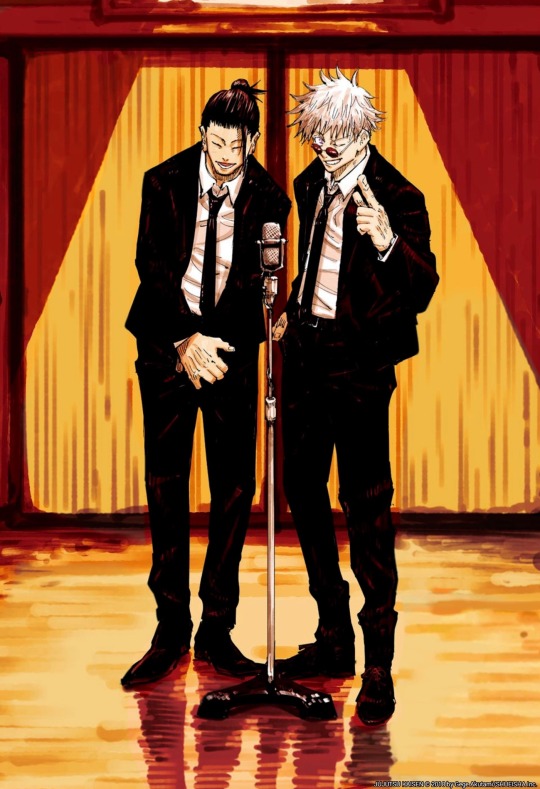
My series on Bonds in Jujutsu Kaisen & their impact on the story, starting with the strongest duo.
Jujutsu Kaisen has become a raging popularity globally in the manga and anime community for many reasons; ranging from the action to the character interactions. In this new series, I’ll be analyzing my favorite aspect of Jujutsu Kaisen (all story media really): The Character Relationships aka Bonds. These can be positive, negative or neutral Bonds, but nonetheless if there is something to dissect then I will!
This First Volume will be different than the rest (for obvious reasons) simply to explain how these will be laid out in this Series. The bonds between characters in jujutsu Kaisen are extremely crucial to the story so I want to be clear how I lay out these posts! So if you’re interested in this continue on!
WARNING: These posts are not for light readers, or skimmers!
Series Set Up:
Each Volume will be broken down into multiple parts (2+), the main parts will always be;
“Who These Characters Are to Each Other” & “Bond’s Story Impact”. There may be additional sections a Volume if it is interesting and/or integral to the Bond being discussed i.e “How this Bond impacts ____” or “Character Romance/Shipping”.
These section titles should be self explanatory so I won’t deep dive into those. Another crucial thing to note for this series is your participation! Please comment below characters you would like to see covered/topics involving them (otherwise you’ll be at my mercy). Also, feel free to ask any questions to me directly, I’m always available!
All of the JJK Bonds posts will be under the “ jjk bonds series” tag! Now, onto the content!
~~~~~~~~~~~~~~~~~~~~~~~~~~~~~~~~~~~~~~~~~~~
Who are these characters to each other?
Gojo Saotru and Geto Suguru, is probably one of the most popular modern relationships in anime/manga may it be for their bond as best friends, their coolness as strong sorcerers, or even their potential as a couple. These two characters are pivotal for the story and are at the center of everything that makes the stories’ events unfold. But let's specifically focus on the relationship between these two.
Known as “The Strongest Duo” when they were just students, Geto and Gojo took on this title proudly, especially Gojo. However, Geto took a more humble approach, and informed Gojo of how his pompous and hubris could be harmful to his image and relationship with his superiors, something Gojo still struggles with to this day. Its interesting because Geto was also very bold with his words he was just much better spoken and poised.
When analyzing these two, the biggest thing that comes to mind is their seemingly conflicting ideals, and even with them the two seemed to agree on enough to consider each other “best friends”. These are the same two who argued over whether or not they should “protecting the weak” but easily agreed to go against the jujutsu society in order to protect Riko (star plasma vessel) if she desired.
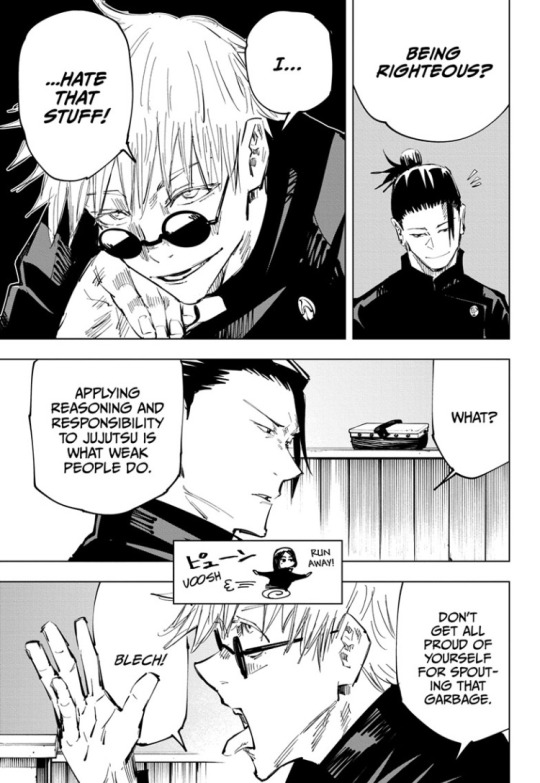

You can say that Geto and Gojo were the perfect partners, understanding each other’s strengths and weaknesses to work together. On top of that they had a true level of trust, to the point that they were confident they could win fighting together no matter who the enemy was. This is one half to the core of their relationship.. Trust. Something that didn't stop even when the two of them became enemies.
Both of them even as enemies considered each other best friends, Geto told his daughters Nanako and Mimiko how important Gojo was to him, hence them not looking for revenge against Gojo, but instead let Kenjaku use Geto’s body to try and accomplish his old goals, but that was not Kenjaku’s plan at all. (RIP Geto’s Legacy)
You ever think about how Kenjaku had never dealt with a body's soul still being active until Gojo said to Geto, “how could you let yourself get used like that Suguru”? I do... all the time... the connection these two had with each other was so strong it awoke Geto’s soul and he has been awake since apparently. You can't be surprised that there are so many people who associate these two’s relationship with romance, because it's clear that Love is the second half to the core of their relationship, may it be taken platonically or not.
This even trickles down to Kenjaku being able to seal Gojo by simply shocking him, appearing as Geto keeping him in thought long enough for the Prison Realm to activate. Only love can shock someone like that, especially Gojo who at the time was heavily focused on the task of protecting the people in B5. I think I've honed in on these two and their relationship together enough, but there is so much you can dissect but it leaves a lot up to personal interpretations, so I’ll share those in a different series and/or format!
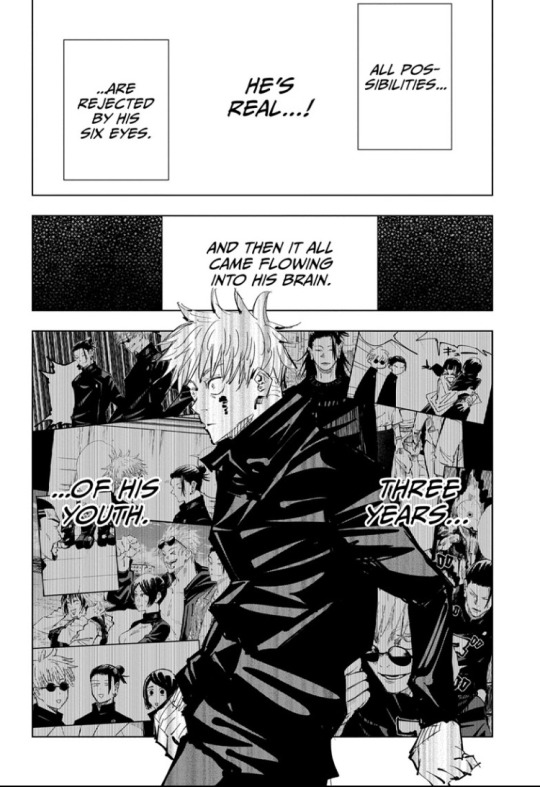
(If interested please comment blow!)
~~~~~~~~~~~~~~~~~~~~~~~~~~~~~~~~~~~~~~~~~~~~~~~~~~~~~~~~
Bond’s Story Impact?
As I dived into at the tail end of the first section, love is the second part to the core of Geto and Gojo’s bond. Like I said previously, whether you treat this love as a romantic or platonic nothing changes the fact that their love for one another helped prop open the door for Kenajaku’s plans.
Hidden inventory is the key arc of reference not only because it is where we see all of Gojo and Geto’s past interactions, it also shows how Geto descended into his dark path. We have to talk about Toji Fushiguro, who of course was the catalyst to Geto’s fall, propelling him into a state of depravity that he felt could only be mended by creating a world with on Jujutsu Sorcerers.
(Yuki plays a part in this as well, but only as an information source, not a true influence of direction).
If Gojo and Geto decide to fight for Riko’s life, then who knows how Kenjaku would have went about his plan, but in the current events Toji interfering with Riko’s decision to live, showed Geto how fragile his power was. Gojo was the opposite, acquiring a state of enlightenment through reverse cursed technique transitioning into the solo “Strongest”. We all saw what this did to Geto, he felt alienated from Gojo.. no longer able to stand by his side but simply watch as he took on the weight of the jujutsu world little by little, while seeing the deaths of other sorcerers begin to pile up... their love began to weaken.. their closeness began to dwindle, and Geto felt that more than Gojo, who had took the opposite approach after Riko’s death.
Its extremely impactful to see Geto reject Gojo’s idea of killing the worshippers who celebrated Riko’s death, while over the next few months Geto became more and more exposed to the atrocities of Non-Sorcerers, may it be out of ignorance or not.. they became all the same to him.. Monkeys.. the thing Toji called himself for lacking Jujutsu. This clearly indicates that Geto was traumatized by Toji’s assault, down to treating Maki like a lesser than being for existing.
(Albeit foolish Geto, If she lack cursed energy entirely that means she can’t create curses.. which is no different than jujutsu sorcerers who just cycle cursed energy in their body.. he was blinded).

Geto loved Gojo, and because they began to separate both in ideals and in strength, Geto began to follow the path he felt would bring his heart happiness. This in turn devastated Gojo, making him fluster in his actions as a jujutsu sorcerer by letting Geto walk away, but not before Geto posses the powerful question of whether he is “Gojo Satoru because he is the strongest or is he strongest because he is Gojo Satoru”. Gojo’s one and only best friend was wondering what defined him, causing Gojo to wonder what the meaning of his strength truly was.
“It looks like me being strong isn't enough, I can only save those who are prepared to be saved”, Gojo had to accept that he could no longer be of help to Geto, and that his pure power could only get him so far. So what is the next step? How does the strongest proceed with more than just power?
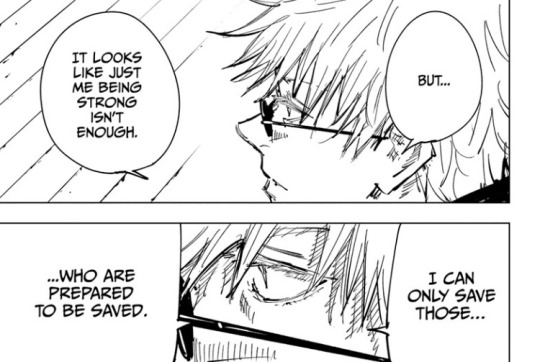
Gojo’s answer was simple; become a teacher, which by an odd turn of events leads him to take on Toji’s son Megumi (best boy), as a student, Gojo’s very first you could say. Gojo then dives even deeper into his role as the strongest, altering the balance between curse users and jujutsu sorcerers. Gojo’s ascent to the strongest was the catalyst for his descent while Geto’s descent was the catalyst for Gojo to become the mentor we love today, who wants to raise allies to change the jujutsu world that plagued Geto’s heart.
Years later, Yuta Okkutsu, enters the Jujutsu World, targeted by Geto for Rika in order to continue the plan to eradicate Non-sorcerers. Gojo is clearly in the way of this, and Rika’s power was something Geto felt could be used to help counter that, not in order to kill Gojo but have the power to proceed without him interfering with ease. Still, with this evil mindset we still see Gojo and Geto have their final moment together after Yuta defeats the latter in battle, with neither one having any form of resentment towards the other.
Gojo even explains to Geto that he TRUSTED Geto to not kill Inumaki and Panda hence him sending them back without worry. Once again, their trust goes beyond their ideals, making it clear that love has to be involved because how can you trust someone who has already murdered innocent people? Including his own parents..
This final moment of love between these two (literally Geto smiling knowing he about to die + that cryptic last line we never hear Gojo say that most likely was “I love you”, because why would Geto say “at least curse me a little in the end”), was their final reconciliation, and it caused Gojo to make a drastic mistake of not letting Shoko destroy his body. This moment of weakness gave Kenjaku the final opportunity he needed to start enacting his plans, and re-establishing the only weakness Gojo Satoru had: his best friend, Geto Suguru.
Fighting back the tears as im writing this LOL
Now, even his strongest student (maki though?!) Yuta Okkotsu, the same student was was the focal point of Geto and Gojo’s final clash and moment, has taken it upon himself to kill Kenajku so that Gojo doesn't have to kill his best friend a second time. The fact Yuta literally says “I won't let sensei kill his best friend a second time” is what shakes me personally. Tis indicated to me that the things Gojo said at the end of JJK Volume 0 resonated with Yuta. Seeing him repeat it back to himself when invoking confidence in his actions screams how impactful those two were to him, even if Geto was his enemy.

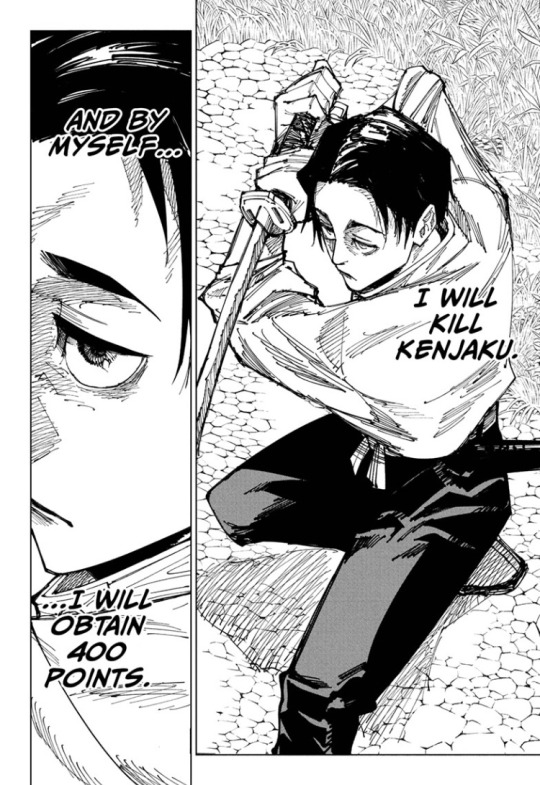
Yuta acknowledges the amount of Love Gojo and Geto have for each other, and he refuses to put his sensei through that again, meaning he will take on their strongest enemy with all the burden attached in order to keep Gojo from reliving that same pain again..
~~~~~~~~~~~~~~~~~~~~~~~~~~~~~~~~~~~~~~~~~~~~~~
Conclusion!
Thank you for reading this very long and maybe drawn out post about two of my favorite characters in Jujutsu Kaisen. I hope I did a good job of sharing with you my thoughts using accurate moments and explanations without doing too much speculation (LOL).
I enjoyed making this post and plan to make multiple series about Jujutsu Kaisen on my blog, among other series in the future! I most likely will add things to this post that come to my mind overtime, so don’t consider this the final product just version 1!
Click “keep reading” below to see information about post submissions, comments and post edit citations! Thank you!!
~~~~~~~~~~~~~~~~~~~~~~~~~~~~~
Quality of Life!
If you are mad because I didn't do a section strictly on the romantic relationship between these two.. do it yourself and submit the post to me, I’ll gladly share it if it has some credible things to it! On the flip side, don't send me “anti-ship” posts on these two, because those will never get read. If you have non hateful reasoning, please make that obvious in your submission!
Keep all hateful comments to yourself, its embarrassing to see you out here like that. We want the best for everyone! But feel free to send to all your friends and call me stupid, everyone needs an outlet.
True Constructive Criticism is always accepted! Thank you!!
63 notes
·
View notes
Photo

Pocky & Rocky 2
At a glance, Pocky & Rocky 2 is exactly what you’d expect from a sequel – it has more stages, more characters, more mechanics, and an entirely new story while retaining the same core gameplay that has made the series a success up to this point. But once you get your hands on it, you’ll quickly realize it’s quite a different experience. As a single player game, it’s the strongest entry yet, providing Pocky with more tools than ever before alongside a gorgeous soundtrack heavy with authentic Japanese instrumentation and a visual feast for the eyes befitting of a 1994 SNES game. As a co-op experience, it’s a lesser choice compared to its predecessor in every way thanks to design choices that (literally) throw player two aside in exchange for enriching player one’s experience. Depending on how you play the game, Rocky may barely even show up at all!
Read more...
#Hardcore Gaming 101#Steven Barbato#Review#Pocky and Rocky 2#action: top-down view#Natsume#player: anthropomorph#player: female#run-and-gun#SNES#Taito#video games
12 notes
·
View notes
Note
Who do you think had the potential to be as strong as yoriichi or maybe even surpass him.
Nobody.
Yoriichi is a character with a classic "lonely at the top" trope, by sheer fluke he is the exception to many natural limitations on mankind, and he can effortlessly tap into skills that take others years and years of dedicated practice before they might have a prayer of attaining them. He is unfairly skilled, and the tragedy is that even though he doesn't have any desire or interest in his abilities, they drive a wedge between him and most people he's ever known, and he's very sensitive to that. That's part of why Uta and the Kamado family were special to him, because even though they were rightly amazed by him, they did not harbor any jealously or desire to posess those skills themselves (in Sumiyoshi's case, he wanted to learn them for Yoriichi's sake, not to make a swordsman of himself).
But, Yoriichi optimistically expressed to his brother that doen the line, centuries later, swordsmen may come who blow them away in skill, so it doesn't matter much if he's around or not. Michikatsu, feeling the bitter sting of their powerful techniques disappearing from the world, seemed to disagree, and in general he wss proven right in the Corp's historical assessment of their swordsmen never quite reaching the skill level of that time period thereafter.
Still, we can consider some characters who had the best chances of coming close to Yoriichi's level:
1. Tsugikuni Michikatsu
Besides pulling from the same gene pool which might had made him inclined to Sun Breathing, so much so that he attained an identical mark, he still never got it and Moon Breathing (however comparible) would never be as powerful. This endlessly frustrated him, and even as a demon who had consumed many people facing Yoriichi in his 80s (the only known exception to the "everyone with a mark dies by 25" rule), he still could not beat him in swordsmanship.
2. Rengoku Shinjuro
Taking him as an example of lifelong swordsmen with access to records of Yoriichi's methods. Despite his dedication to his craft, he identified a huge gulf between his ultimate potential and the abilities of a naturally talented person like Yoriichi. Hoping to attain anything like that was futile, however much they might have strived to model Flame breathing on Sun Breathing.
3. Himejima Gyomei
Taking him as an example of the physically strongest of the Pillars, the strongest of the strong, as well as someone with years of experience and training. While he did attain the ability to see the see-through world like Yoriichi easily could since childhood, Himejima was still unable to escape the limitations of the mark (he and Kokushibo both seemed pretty sure he'd die the night it showed up), thereby limiting how far his training could had taken him.
4. Tokito Muichiro
Our Boy Genius of the Taisho era, and pulling from the same gene pool. However, Mist Breathing technique has already gotten a pretty far cry from Sun Breathing's style even if the core of it is the same, and Muichiro wasn't quite the same level of exceptional Yoriichi was born as. While he might had gotten closer after another decade of training (though I think he would had stayed pretty set in his Mist approach), his struggles against the Upper Moons show that he's still got a long, long way to go before he'd have the capability of taking on Muzan by himself.
5. Kamado Tanjiro
Our hero, who grew up learning Sun Breathing technique, and with only a few years of dedicated swordsmanship he climbs up the Corp ranks like mad as he picks up training and techniques from characters all around the cast, even got as close as anybody could to training with Yoriichi himself via inherited memories of Sumiyoshi observing Sun Breathing and via the battle doll in the Swordsmith Village.
But for as hard as he works and whatever natural inclination Tanjiro may have, he's no genius.
By the end of the series Tanjiro has not reached his full potential yet (even setting aside his retirement-worthy injuries). He was well on his way to being a Pillar, but there was still a huge gulf between them. We could still theorize all we want about his potential to exceed the 25-year-old limitation due to his mark, but even if Tanjiro could had reached heights that the Corp hasn't seen in decades or even centuries, he still would be very, very unlikely to face Muzan alone and live to tell the tale unscathed. (The fact that he lasted so long against him while the others were down goes to show just how powerful Sun Breathing is, even in its rough and imperfected form with a severely injured wielder.)
Ergo.
When it comes down to it, hard work should always be held in higher regard than natural talent, because talent will typically be wasted without polishing. At least, that is the case for the vast majority of us humans, and everyone can be a better version of themselves if they work hard.
But, for as remarkable as people may become in their respective crafts, something they dedicate their lives to perfecting and becoming the best at it, there's still the humbling knowledge or deep fear that raw talent will always provide a maddeningly unfair edge.
#tsugikuni yoriichi#kimetsu no yaiba#demon slayer#tsugikuni michikatsu#kokushibo#rengoku Shinjuro#himejima gyomei#tokito muichiro#kamado Tanjiro
95 notes
·
View notes
Note
Something about Quina in FFIX - Their magic reflects their personality to the dot. Quina is erratic, carefree, absurd to the core, and strong willed. Their magic is bizarre, whimsical, unpredictable, and powerful.
The fact they're the embodiment of the game's message is even more spectacular. They deserve more love. WE NEED MORE QU IN THE SERIES DAMMIT! Give us young Qu, old Qu, adolescent Qu, parents who are Qu, whole societies of the Qu!
Oh, btw, rename Quina to Quart to play into their Gourmand side. You're welcome
You: Here is an extremely good take on Quina and why they're actually a fantastic character and addition to the main cast.
Me: I owe you my life
You know what takes years off my life? Everytime I read an article that's like "TOp 10 ChaNgeS ThEy ShoUld mAke tO A Ff9 ReMaKe" and then they have the AUDACITY TO SAY "REMOVE QUINA FROM THE GAME. OR I read a post that says "You could remove Quina from the game and nothing would change."
Excuse me? Nothing would change?? Remove Quina? My non-binary Qu LEGEND??? The REASON why you are able to go to the Lost Continent. The character that knocks Zidane off his confident feet and teases out a frustration from him that no other character can do??? The self-aware, confident, ROCK OF THE PARTY. THOSE PEOPLE ARE SO WRONG. But you are absolutely RIGHT saying Quina is strong-willed. They have the strongest will of ALL the main characters. In a group of characters questioning themselves, doubting themselves, and facing their insecurities Quina is the wise old friend who's there for practical good old advice - even if it goes over everyone else's heads - and is always there when you really need them. May Quina EAT anyone who questions their presence in the game.

Quina is a genius character from a design perspective too because the game designers needed a character to come in and out of the party for characters like Steiner and Eiko to enter the party in Disc 2. You never really question when Quina just goes running off and leaves the party because that's just Quina. But it happens at the perfect time for another member to join up.
You also NAIL IT saying Quina embodies the game’s message. I’ve been screaming this forever so THANK YOU FOR THE VALIDATION. Quina gives an essential lesson that ties in well with the theme of the game. Quina’s journey may seem surface level ridiculous and silly - a constant search for good food - but let’s substitute eating for experiences. “To eat is to live.” Or rather, to experience is to live. The people that are “hollow,” or considered “lifeless puppets” are alive but they have yet to begin to live until they get the chance to experience the world around them. Quina is the one character who gets this in a sense. They aren’t afraid to live. They aren’t afraid to experience. As Zidane says at the end of the game, “even if we’re born to die, I’m not afraid. I’m gonna live!” Quina will die one day, and comes very close to it, at some points like in Cleyra. But that doesn’t deter them. Quina races forward to eat and experience as much of life as they can even in the face of death that looms in the world of FF9 and our own. Quina is the one character who, from the start, embodies Zidane’s quote. They are not afraid, they simply live. We could all take a page out of their book.
Also it’s time for Quina appreciation. This compilation video is a riot from Vinesauce’s FF9 stream. FF9 is one of his favorite games so he plays it with love, his Quina voice is amazing, and it’s a riot how he goofs on Quina, while they slowly become a highlight of his playthrough.
This art by dv9lity on twitter (click the link for the full art) from the stream, inspired by the Vivi, Quina, Quale, and Quan scene, is also incredible. Anyone who hates Quina is small, peanut brain. All those who love and appreciate Quina? Galaxy brain. Don’t be like Zidane. Embrace imagination, embrace Quina.

I guess I can also mention/plug my Quina fic. The only Zidane & Quina fic currently which is a crime. Give me more Quina content. Give me more Quina bonding with the others. Quina would give the best hugs. We need to take advantage of that potential.
You’re also FREAKING RIGHT. The Qu’s are such an awesome fantasy race! I’M SICK OF HUMANS SQUARE ENIX. THEY’RE BORING, OVERUSED, GIVE US THE FANTASY RACES WE DESERVE. FF9 had PEAK fantasy world with its hundreds of different races. We will never achieve such heights again. Just look at the main cast. They’re so diverse, colorful, and fun together - I want that again.
#asks#mystic-mongrel#Quina#ffix#final fantasy ix#quina quen#final fantasy 9#Also quart for quina is hysterical i love that
37 notes
·
View notes
Text
Alright everyone I'm back and continuing my Strange Variant series! Today we're doing Defender Strange's team, or as I like to call them, Team Defender. As a quick side note I've pretty much decided that all Strange variants have at least one sort of "cute" Pokémon who serves more like a pet or mascot than a fighter. Yeah I have no excuse except I wanna see Benedict Cumberbatch with cute Pokémon.
Don't judge me.
That all being said, let's take a look at:
Team Defender!
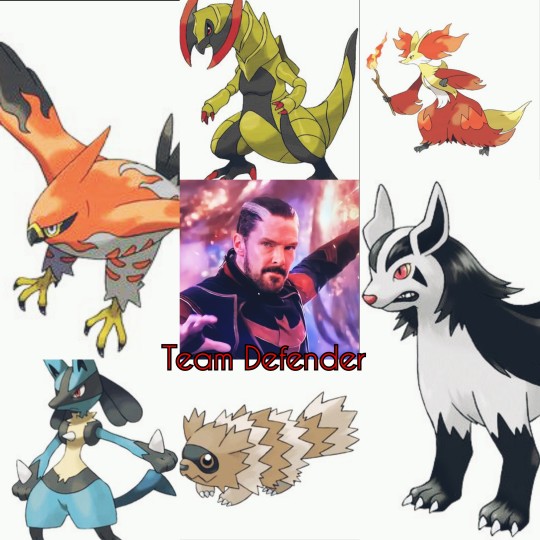
1. Talonflame
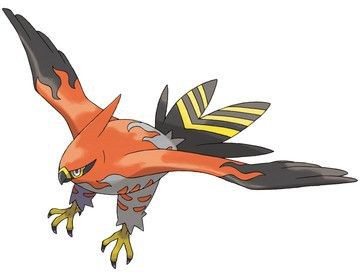
I'm pretty sure you can guess why I put talonflame on the team. It's the bird motif man, and it's strong here. Talonflame is Defender's lead Pokémon, and his fastest. However its not his strongest. This bird is brash, bold, and unafraid to put any Pokémon or supernatural entity in their place.
2. Haxorus
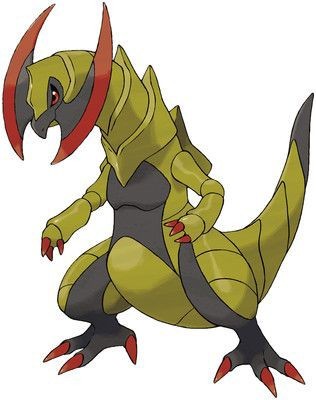
Hax is the only surviving member of Team Defender, sadly. I love the idea of Defender Strange with a dragon, but I wanted him to have one that wasn't necessarily goofy looking or over the top. Hax is imposing but has a surprisingly gentle nature despite his appearance and ferocity in battle. He becomes something of a Guardian to America Chavez, integrating into her team of mostly fighters and fairies. Hax sticks out like a sore thumb and he's okay with that.
3. Delphox
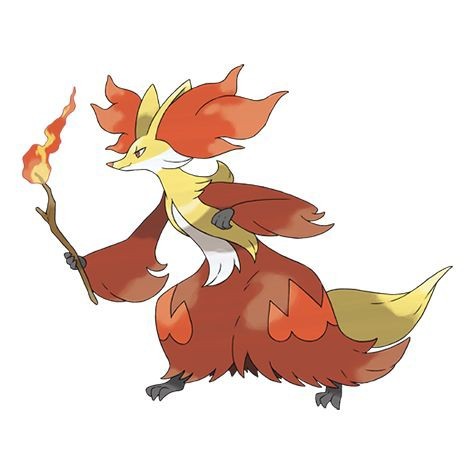
Okay maybe there's a little bit of a fire motif with this team too, because this one was a toss up between Delphox and ninetales. Delphox won because she's part psychic as well, and I like the idea of Stephen having a psychic type in every universe. It may also come as no surprise that Delphox is also the most magically gifted of Team Defender.
4. Mightyena
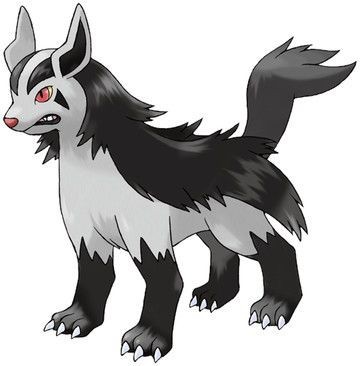
Every team has a dark side and mightyena is kinda the representation of Defender's inner darkness, perhaps even a foreshadowing of what he becomes later in Multiverse of Madness. Mightyena is brave, loyal to the core, and evolved surprisingly quickly. He's usually there to help the team get out of serious trouble, seeing his comrades as his family/pack.
5. Lucario
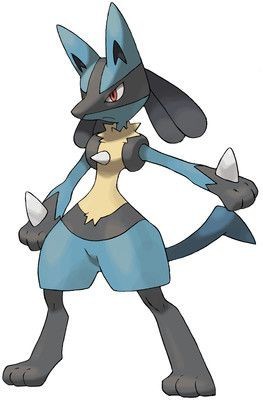
We all know Stephen's all about the auras, and what better Pokémon to pick up on those than Lucario? He's a direct rival of the Delphox, believing more in physical might than magic. I believe this was his second pokemon, potentially hatched from an egg, so Defender feels a very close kinship to his Lucario, and the feeling is very much mutual.
6. Zigzagoon
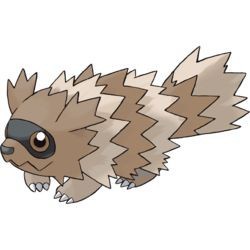
Like wooloo I have no excuse. I love this Pokémon, and for some reason I feel he just vibes with defender Strange. Seen oftentimes riding around on his shoulder or on mightyena's back, zigzagoon is a little adventurer. He loves to travel and do things with his friends. He's not very strong but he's the sort of heart of Team Defender.
And that concludes Team Defender! I'll be doing Supreme Strange (838 Strange) next time! Thanks for reading and don't forget to stay awesome!
#pokemon#marvel#crossover#pokemon crossover#pokemon teams#pokemon team#dr. strange#defender strange#zigzagoon#lucario#delphox#mightyena#haxorus#talonflame
3 notes
·
View notes
Text
Osblaineweek2021, Day 2: Prose
I love book quotes. Looking at quotes is one of my favorite ways to to inspire myself to write more fic.
Here’s a small collection of book quotes (and recs!) of where I’ve “found” June and Nick.
This post contains spoilers for the following books/series:
- Lover Mine by JR Ward
- The Wrath and The Dawn duology by Renée Ahdieh
- A Court of Thorns and Roses series by Sarah J. Maas
Lover Mine by J.R. Ward
Summary:
John Matthew has come a long way since he was found living among humans, his vampire nature unknown to himself and to those around him. After he was taken in by the Brotherhood, no one could guess what his true history was- or his true identity. Indeed, the fallen Brother Darius has returned, but with a different face and a very different destiny. As a vicious personal vendetta takes John into the heart of the war, he will need to call up on both who he is now and who he once was in order to face off against evil incarnate.
Xhex, a symphath assassin, has long steeled herself against the attraction between her and John Matthew. Having already lost one lover to madness, she will not allow the male of worth to fall prey to the darkness of her twisted life. When fate intervenes, however, the two discover that love, like destiny, is inevitable between soul mates.
It's basically a paranormal love story between two warriors. He's really young (although he's actually a reincarnation of a very old vampire warrior, but he doesn't know that), and she's like 300 years older than him. In this book, she's been raped and abused by a guy who also used to bully him. She escapes, but he saves her life. She's hungry for revenge and wants to die after achieving that goal, but of course eventually changes her mind. In the end he actually serves her rapist to her on a silver platter so that she can kill him (sound like anyone we know?). He literally holds the guy down while she kills him.
They're my ultimate favorite ship in this series, and IMO their relationship eventually develops into one of the strongest ones. This series is a bit of a hit-or-miss for most people, because the language and the writing style are pretty ridiculous in all seriousness. If you decide to read this, I recommend starting the series from the beginning because John and Xhex meet for the first time several books before this one, LOL.
Here are some of the quotes that make me think of Nick and June:
“Besides, the story of the two of them was written in the language of collision; they were ever crashing into each other and ricocheting away—only to find themselves pulled back into another impact.”
― J.R. Ward, Lover Mine
“As his ears rang and his heart broke for her, he stayed strong against the gale force she let loose. After all, there was a reason why here and hear were seperated by so little and sounded one like the other. Bearing witness to her, he heard her and was there for her because that was all you could do during a fall apart.
But God, it pained him to see how she suffered.”
― J.R. Ward, Lover Mine
“...the only thing that had tethered her to the earth had been him and it was strange, but she felt welded to him on some core level now. He had seen her at her absolute worst, at her weakest and most insane, and he hadn't looked away. He hadn't judged and he hadn't been burned.
It was as if in the heat of her meltdown they had melted together.
This was more than emotion. It was a matter of soul.”
― J.R. Ward, Lover Mine
The Wrath and the Dawn duology by Renée Ahdieh
Summary:
One Life to One Dawn.
In a land ruled by a murderous boy-king, each dawn brings heartache to a new family. Khalid, the eighteen-year-old Caliph of Khorasan, is a monster. Each night he takes a new bride only to have a silk cord wrapped around her throat come morning. When sixteen-year-old Shahrzad's dearest friend falls victim to Khalid, Shahrzad vows vengeance and volunteers to be his next bride. Shahrzad is determined not only to stay alive, but to end the caliph's reign of terror once and for all.
Night after night, Shahrzad beguiles Khalid, weaving stories that enchant, ensuring her survival, though she knows each dawn could be her last. But something she never expected begins to happen: Khalid is nothing like what she'd imagined him to be. This monster is a boy with a tormented heart. Incredibly, Shahrzad finds herself falling in love. How is this possible? It's an unforgivable betrayal. Still, Shahrzad has come to understand all is not as it seems in this palace of marble and stone. She resolves to uncover whatever secrets lurk and, despite her love, be ready to take Khalid's life as retribution for the many lives he's stolen. Can their love survive this world of stories and secrets?
This is a young adult fantasy romance, and basically, Khalid is a lot like Nick. He’s made mistakes that he needs to own, but at the same time he’s forced to commit atrocities he doesn’t want to do. He hates himself and doesn’t believe himself to be worthy of love, and yet he falls in love with Shazi. He's viewed as the villain of the story by everyone aside from Shazi and a few other characters until almost the end of the 2nd book.
“I love you, a thousand times over. And I will never apologize for it.”
―Renee Ahdieh, The Wrath and the Dawn
“It’s a fitting punishment for a monster. to want something so much—to hold it in your arms — and know beyond a doubt you will never deserve it.”
― Renee Ahdieh, The Wrath and the Dawn
“When I was a boy, my mother would tell me that one of the best things in life is the knowledge that our story isn't over yet. Our story may have come to a close, but your story is still yet to be told.
Make it a story worthy of you”
― Renee Ahdieh, The Wrath and the Dawn
“In that moment of perfect balance, she understood. This peace? These worries silenced without effort? It was because they were two parts of a whole. He did not belong to her. And she did not belong to him. It was never about belonging to someone. It was about belonging together.”
― Renee Ahdieh, The Rose & the Dagger
“A boy who'd thrived in the shadows.
Now he had to live in the light.
To live . . . fiercely.
To fight for every breath.”
― Renee Ahdieh, The Rose & the Dagger
A Court of Thorns and Roses by Sarah J. Maas
Summaries:
Book 1
Feyre's survival rests upon her ability to hunt and kill – the forest where she lives is a cold, bleak place in the long winter months. So when she spots a deer in the forest being pursued by a wolf, she cannot resist fighting it for the flesh. But to do so, she must kill the predator and killing something so precious comes at a price ...
Dragged to a magical kingdom for the murder of a faerie, Feyre discovers that her captor, his face obscured by a jewelled mask, is hiding far more than his piercing green eyes would suggest. Feyre's presence at the court is closely guarded, and as she begins to learn why, her feelings for him turn from hostility to passion and the faerie lands become an even more dangerous place. Feyre must fight to break an ancient curse, or she will lose him forever.
Book 2
Feyre survived Amarantha's clutches to return to the Spring Court—but at a steep cost. Though she now has the powers of the High Fae, her heart remains human, and it can't forget the terrible deeds she performed to save Tamlin's people.
Nor has Feyre forgotten her bargain with Rhysand, High Lord of the feared Night Court. As Feyre navigates its dark web of politics, passion, and dazzling power, a greater evil looms—and she might be key to stopping it. But only if she can harness her harrowing gifts, heal her fractured soul, and decide how she wishes to shape her future—and the future of a world cleaved in two.
With more than a million copies sold of her beloved Throne of Glass series, Sarah J. Maas's masterful storytelling brings this second book in her seductive and action-packed series to new heights.
Fantasy romance with explicit sex scenes, and book 2 is a lot better than book 1. Our main character Feyre falls for a really boring fae guy, but also meets the hottest guy she’s ever known. The first guy of course isn't the real love interest (this is a twist this author loves to do). They all end up as prisoners, and the 2nd guy saves her life when the 1st one is totally useless. He also makes her hate him as he does it because he has to. After getting out, she tries to make her old relationship work, but it doesn’t, and guess who swoops in?
I do see some Nick in Rhysand (in addition to his role in the love triangle). They’re both traumatized and prefer to keep a lot of their feelings to themselves. I also see some of the same selflessness in both of them. Rhysand wants Feyre to choose him because she loves him, but he’s willing to accept that she may not, and doesn’t tell her that they’re pretty much destined to be together (it’s a supernatural thing, and he will suffer a lot if she decides she doesn’t want him).
“Everything I love has always had a tendency to be taken from me.”
―Sarah J. Maas, A Court of Thorns and Roses
“It took me a long while to realize that Rhysand, whether he knew it or not, had effectively kept me from shattering completely.”
― Sarah J. Maas, A Court of Thorns and Roses
“Regardless of his motives or his methods, Rhysand was keeping me alive. And had done so even before I set foot Under the Mountain.”
― Sarah J. Maas, A Court of Thorns and Roses
“Because," he went on, his eyes locked with mine, "I didn't want you to fight alone. Or die alone."
― Sarah J. Maas, A Court of Thorns and Roses
“He thinks he'll be remembered as the villain in the story. But I forgot to tell him that the villain is usually the person who locks up the maiden and throws away the key. He was the one who let me out.”
― Sarah J. Maas, A Court of Mist and Fury
“And I wondered if love was too weak a word for what he felt, what he’d done for me. For what I felt for him.”
― Sarah J. Maas, A Court of Mist and Fury
“I was his and he was mine, and we were the beginning and middle and end. We were a song that had been sung from the very first ember of light in the world.”
― Sarah J. Maas, A Court of Mist and Fury
25 notes
·
View notes
Text
My Little Pony - I watched all 9 seasons (and you should too)

Back in college I went from watching a YouTube video joking about My Little Pony: Friendship is Magic to actually watching the show for myself and realizing that it’s unironically fantastic. I can’t pinpoint an exact year for this, but I imagine it be roughly around 2012? Well, now that it’s 2021, I can finally write down my final thoughts on the show having finished it last year. I picked up where I had left off many years ago, and it’s definitely a come-full-circle feeling.

When people think of the MLP brand, especially as it regards MLP: Friendship is Magic, there’s usually only 2 associations that will pop into someone’s mind. Either its target audience of little girls, or worse - the internet phenomenon that was brony culture. Adult men in their 20s and 30s who tuned into the show and used the jokes within the writing & animation on 4chan and other internet boards. Of course there’s definitely more to the brony aspect of the fandom than meets the eye, and any negative stereotypes arising from this association are just that. Stereotypes.
But I think as cringey as the most extreme aspects of what I will refer to as “bronydom” are, I think that these 2 vastly different demographics really does touch on what makes MLP: Friendship is Magic so special. This show that was clearly geared for kids touches on so many universal themes (and does so shockingly well), that anyone can find appreciation for it. And the show deserves nothing less than that - the art style is appealing as all heck, the characters are extraordinarily charming, and the storylines are compelling.

Of course, I will take the time to lay out that the show is at its strongest when looking at the personalities of the core cast of characters - or as they’re best known - The Mane Six. (Yes - that’s mane - not main, haha)
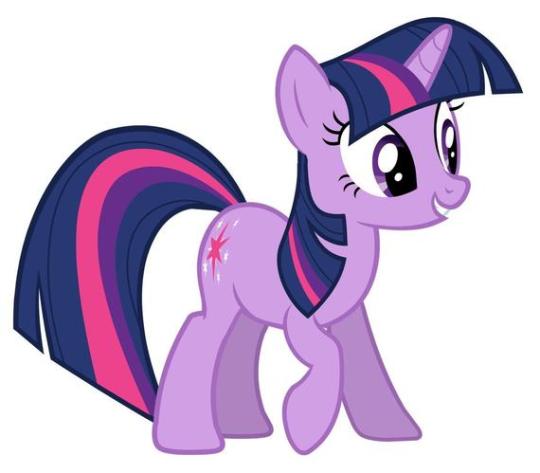
The main protagonist of the show is the unicorn Twilight Sparkle, who excels in academics and is exceptionally talented in magic. But she lacks socialization with her peers, and is sent by her mentor Princess Celestia to the town of Ponyville to make some friends.
While there, she meets the rest of the gang -
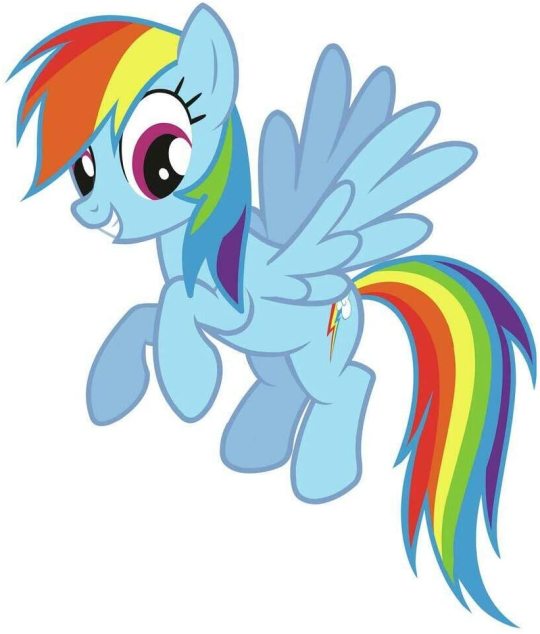
Rainbow Dash, a brash and athletic pegasus who dreams to join Equestria’s most elite flyers - the Wonderbolts.

Applejack - a hardworking and steadfast earth pony who helps run her family’s farm - Sweet Apple Acres.

Rarity - a beautiful and fashion forward unicorn who runs her business, Carousel Boutique in Ponyville.

Fluttershy - the sweet and bashful pegasus who has a special talent for caring and connecting to all creatures big and small.
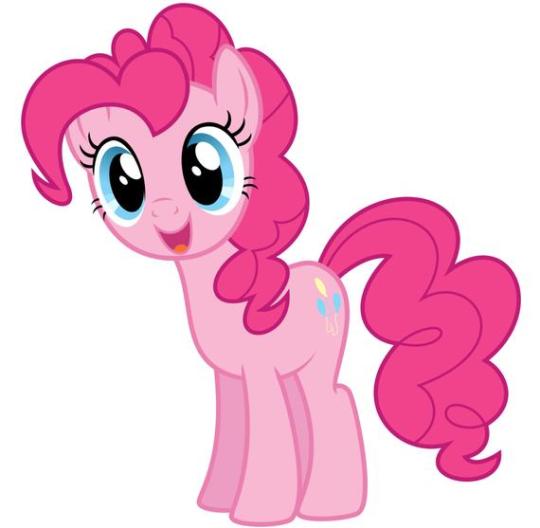
And Pinkie Pie - a spirited and party loving earth pony, whose biggest passion is to make those around her smile and laugh.
These are classic character archetypes, and while MLP: Friendship is Magic boasts solid writing, it cannot boast innovation on that front. But each of the characters do have enough individuality and depth that there are plenty of instances where they veer from their archetype qualities.
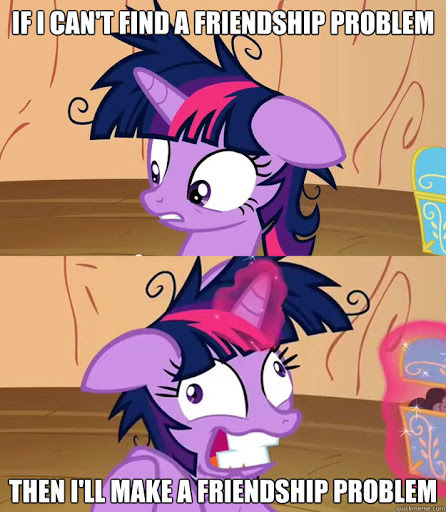
Most notably, these characters’ personalities are all flawed - something that is hugely relatable to everyone - children and adults alike. Our flaws define us as much as our strengths. And accordingly, our flaws lead us into conflict. The show is surprisingly realistic about how much that plays into friendships and laying out the lessons to learn from that. While these lessons may be newer to the youngsters that the show is meant to target, they are lessons that should speak strongly to adults as well. After all, we never stop running into conflicts in our relationships, even as we grow older. It’s an achingly human quality that follows us throughout our life. So is it really that surprising when you see the adult demographic that enjoys this “little girls show”?

Furthermore, throughout the 9 year run time of My Little Pony: Friendship is Magic, these conflicts are explored from the show’s beginning to its end thoroughly, and while the cast still consistently must resolve conflicts in each episode, the core cast of characters do not remain the same. They each grow significantly and evolve into mentor and leadership roles. They all take steps to achieving their goals and dreams - together.
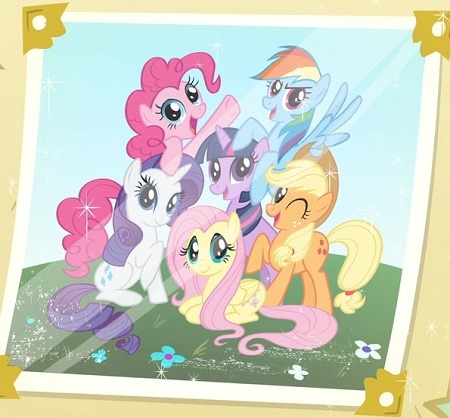
It’s the perfect formula to a long lasting IP. And while certain jokes and gags did get old in the later seasons of the show, and sometimes the writers were a little overzealous in creating character decisions made for arbitrary conflict - fundamentally the writing holds up to the very end. I believe that is specifically due to the poignant quality of the show’s theme: Friendship is not always the easiest to uphold, but the best friendships do make life so much richer and wonderful. Good friendships are worth the work of keeping strong and alive. We are better together than alone.

So as an adult, is it worth checking out this show, beyond the internet culture aspect to it? I would say that anyone who gives the show a legitimate chance will be shocked at how much there is to latch onto and get value out of. There are 9 seasons worth of pop culture references and homages, a gaggle of great side characters (in addition to the core cast), and surprisingly epic moments that had me comparing fight sequences in My Little Pony to fight sequences in shonen anime arcs, and the MCU. (I’m not kidding about that either - this show has insane lore and I recommend this YouTube video series on it: The Complete My Little Pony: Friendship is Magic Timeline (2020) if you want to see the history of Equestria in chronological order. In addition to any epic story arcs, the world building in this show is actually quite massive.)
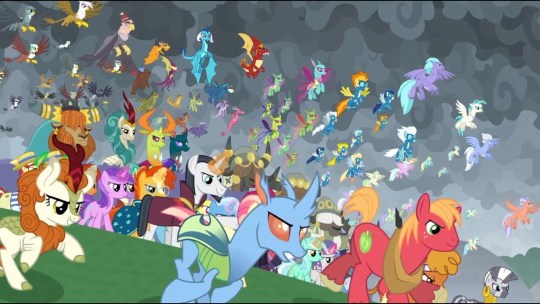
Now admittedly, the show did go through a couple of unnecessary overhaul arcs to keep it alive for longer (as all long running TV shows can be guilty of). But MLP is less egregious in its quality dip than a LOT of other TV content that I’ve consumed. The ending does wrap everything into a neat little bow that as a fan, I was pretty happy with, and I think newcomers into the franchise will be pleased as well.
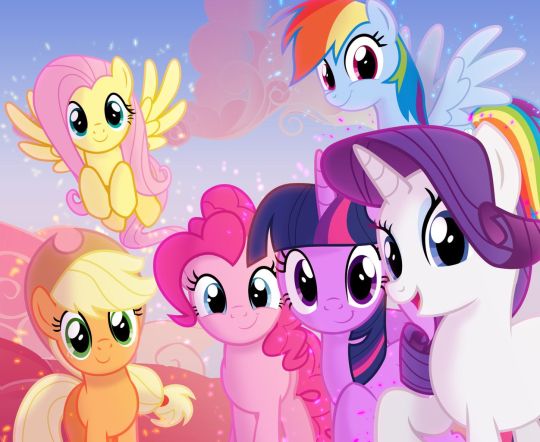
Ultimately, My Little Pony: Friendship is Magic IS something very special. But only can be benefited from, by those who are open minded to seriously consume it. Cheers to my wrapping the show up and giving the later seasons a fair chance. Though it’s outclassed by some other animated content, I would say few to none outclass it within its own genre. And few outclass it even within the confines of animated television as a whole.
Friendship forever. :)
#my little pony#my litte pony friendship is magic#mlp friendship is magic#series review#mlp fim#twilight sparkle#fluttershy#rarity#rainbow dash#applejack#pinkie pie
18 notes
·
View notes
Text
Absurd Person #1 - Monkey D. Luffy (kid)
Let’s start with not only the main protagonist of One Piece but also the first character to give Luffy any sort of injury...
...his dumb, seven-year-old self...

*Disclaimer: I don’t own this image - screenshot from Episode of East Blue
The last time I wrote this, I forgot to hit save and my browser just reloaded the page and lost everything. After that I just went “I’m done” and rage quit Tumblr for the night (which I normally don’t do). That’s how my Sundays usually go😒🥴
Now Onward!
Basic Classifications
Real World Ethnicity/Nationality: Brazilian
Class: farm / country / lower class
Culture (the one he grew up around): Dawn Island - Sea-side village
Fishing community
Farming / Ranching community
Hard work ethic
Small and close community members; relatively friendly; little to non-existent conflict
Selective mix of being open towards strangers (especially with merchant vessels for better trading opportunities) and weariness towards those they expect to be harmful (likes Pirates; I’d imagine the people of Windmill Village were understandably unnerved with the Red-Haired Pirates first showing up).
Core values (personal to Luffy): pride, physical strength, adventures on and outside his home village,
Relation to authority: neutral - shifting slightly towards negative (no clear basis of opinion; can only go off on Luffy’s fascination with pirates as the main viewpoint)
(The added information feels a little scatter-shot but figured I give it a try based on little information from the manga panels and how it lines up with real-world similarities. Most information is based on logical speculation and could change with new information in later chapters.)
I know that the Romance Dawn arc consists of the chapters up until he meets Coby and Alvida (I think...), but the depiction of Luffy’s character in the first chapter seems different from when he is seventeen and setting out to sea. So, I’ll treat kid Luffy as a separate character for the first analysis.
First Impressions and Introduction
Now, I am an anime watcher, first and foremost, so my first impression of this character stems from the Anime. My introduction towards this ball of chaos was when he popped out of a barrel, that he put himself into after realizing that a whirlpool suddenly appeared (how he missed it? - It’s Luffy), and then inexplicably took a nap in. That was the absurd reason I was able to stick with One Piece in the first few arcs (until Baratie became one of the major reasons I stuck with it - I’ll explain why when we get there).
And since the first chapter was used for episode four in the anime, I was already somewhat familiar with how the story started and who Luffy was as a kid. However, reading the first chapter felt....different than what I would’ve expected. And because the anime cut out a few details from the chapter, there definitely are some things to take from kid Luffy at that point.
So my first impression was, as follows:
The kid is unhinged...That explains some things...
Complete wild child of a backwater village from Day 1.
LIKE-- The anime episode DID NOT explain how he got that scar and the guy didn’t bring it up ever. To be fair, that wasn’t a big focus because the anime didn’t make it a focus. Reading that part though did more for his character and a little of his upbringing, through speculation, making it a rather slow-building but also fascinating introduction into this series.
Just a bit of an add-on, but if the manga introduced Luffy in the same level of neutrality as what the Anime did, It may not have fully made it clear if Luffy was going to be the main protagonist. Then again, it’s a shounen manga, maybe it was rather obvious to everyone else. Regardless, his introduction served to
(1) Make his entrance memorable
(2) Establish his character that could either compare or set him apart from his teen self.
(3) Act as a sort of precursor towards the introduction of Luffy’s world and upbringing (which isn’t completely established until the last few arcs of Pre-Time Skip)
Personality
The best way I could describe Luffy at this point is a stereotypical kid...
Energetic, short-tempered, adventure-seeking, easily impressed, and ignorant...
That last description is actually something I brought up in a separate post about the “Fluid themes” of One Piece. Because I found that a small but overarching part in many (almost all) themes and world issues that One Piece reflects has some level of unawareness or apathy. Jimbe put it best during the Fishman Island Flashback when they found Koala (paraphrasing)
“They are afraid of us because they don’t know us.”
Know us referring to acknowledging them as people on the same level as humans.
Because of that and plenty of other instances from the East Blue, it can be a potential center for many characters who go up against or wish to explore the world and find that they are a frog in a well.
And that’s what kid Luffy represents. A rather aggressive frog in a well that wants out.
Granted, he is a seven-year-old, whose schooling has a closer equivalent to the 16th and 17th centuries of our world, living in what appears to be a farming community, so I’d imagine his education only focuses on at least the basic levels of reading/writing, mathematics, etc. A small, unexciting farming village probably has more concerns over their melon crops rather than what the world has going on. Adding in Luffy, you get a kid who dreams about being a pirate and adventuring outside the isolated village, making him avidly interested in a world he has no experience with. Or in a world he thinks is all fun and games.
That’s pretty standard for any child that has a mild and peaceful life. No doubt Shanks and his crew would tell him stories about their adventures. Not as a sort of attempt to make him a pirate, but because he was easily entertained by it, building up this expectation with stereotypical pirate personas. And whether he has his “destructive” tendencies before they became a fixture in Windmill Village, they definitely seemed to amp it up enough for Luffy to try and prove he was “man enough” to be a pirate at seven years old.

Then when you add in this idealistic expectation with the selfishness of a young child, it creates an opportunity to learn. Because, as any kid may go through, will find that their fantasy of the world won’t be what they expected, and will often react negatively. Luffy’s expectation of Shanks is that he is the strongest man worthy enough to be a pirate.
Now, Luffy’s view of a “real man” stems a lot from this stereotype of men solving their problems through fighting only. Which also embodies this rather damaging philosophy of never running away or backing down from a fight (which I refer to as stupid bravery - something that comes up in a certain other character).

The amazing thing about all the combined aspects of this kid is the ability to create a learning lesson for Luffy. Which can become a motivational factor in his pursuit as a pirate.
His easily impressed nature makes it known both when the Red-Haired Pirates talk positively about piracy adventures and when Shanks leaves the village. The difference between the moments can be showcased by the difference in determination and will to make an effort to achieve his dream. As he declared he wants to be King of The Pirates, he sets himself to work at it, rather than try and go with others.
How He Shapes the Story / World Around Them
I don’t know if anybody else made a similar connection (I wanna say someone DID but I can’t remember where) but in combination with Luffy’s general enthusiasm growing up hearing wild stories, his narrative reminds me so much of Don Quixote De La Mancha.
It’s been a while since I last read that story-- and by read I mean translate some paragraphs from Spanish to English during my Spanish I class in freshman year of high school. Nonetheless, I thoroughly enjoyed the story. Part I entails an old man who, after indulging himself with various stories of knights and valor, decides he wants to partake in his own adventures. Under various delusions and misadventures, his story becomes a rather well-known one.
Don Quixote was called the first “modern book”. That was something my Spanish teacher mentioned regarding its acknowledgment by the world and always stuck with me. It was one of the first stories of the early medieval period to focus on a regular man. Other stories before this tended to be about legends, gods, demigods-- individuals who often were referred to as legends because they were born into high status (often above humans). Either through original texts (often for religious purposes) and then through varying interpretations (such as the Arthurian Legends), these tales were a part of the status quo.
Kid Luffy is a person that reflects so much of the Don Quixote story (And not just because his village has windmills-- the most iconic scene about the knight’s story). He is that simple, normal boy that longs for his own adventures when there seemingly is already a well-talked-about story about someone who achieved infamy. In place of that is a man named Gold Roger whose execution we see in the manga’s opening. At this point, we don’t have much understanding about how it impacts the world as of yet, we just know it is setting up for something significant to the story.
Luffy becomes that “regular” person from a small-town with big expectations for a grand adventure.
That perspective can slowly build into the story by starting in a simple setting with a character going through one of the first dynamic changes in his life. Luffy’s experience with Shanks’s sacrifice sets a course in his own adventure. A story that trails into a rather bonkers adventure at the end of chapter 1.
His development is what shaped his world. It’s the way he learns when as it stems from the consequences of his actions. Especially ones where the smaller ones turn out to be very costly, making it a hard lesson that ingrains into the young kid. His actions created by his old ideologies sparked an intense reaction in the people around him. Especially Shanks, who felt he was worth losing an arm towards.
How The WORLD Shapes HIM
So, for the sake of the fact that kid Luffy’s “World” in Chapter 1 mostly consists of Windmill Village, I’m adding in Shank’s and his crew’s influence to extend and further give credence to his influence. Because, as of this point, Shanks represents a glimpse into the life of a pirate that Luffy strives for.
With Luffy being in a quiet environment all seven years of life, there is growth through basic schooling and healthy child development (theoretically since Makino seems to be the most likely one acting as his guardian), instead of doing things outside that norm. Now Shanks is the odd factor that creates new development into Luffy’s dreams and future ambitions.
The crew’s stories, charisma, and connection towards the kid actively (and probably unintentionally) created a positive expectation if he chose to pursue his dream. While that sounds inspiring, there were also negative aspects. Such as driving his ignorance and impatient nature to seek it out too early in his life.
Shanks then became a mediator. Luffy often has mixed feelings with Shanks as the man begets a level of encouragement while verbally making fun of Luffy for being a kid constantly. Despite that, it doesn’t completely deter Luffy’s ambitions. All it does is slowly drop his high expectations in Shanks after the first bar incident. This is again done by his childish outlook of physical strength and bravery equating to his ideal of a real man.
With Higama, Luffy learns about real-world dangers, and how bravery won’t always be enough to win battles. The same can be said for physical strength but at that moment it doesn’t apply to Luffy.
Shanks’ and the crew’s involvement helped Luffy’s views change. His expectations are fulfilled, which in turn reveal that he was wrong about them.
Finally, seeing Shanks’ sacrifice unfold drove Luffy into a pang of newfound guilt. By then, he was able to change one part of his world views from a childish fantasy into the beginnings of a mature way of thinking.
He gains some level of patience. Along with a set goal to work with. Attributes which are identifiable with Luffy in the chapters last few panels.
Patience = Luffy took time to train and learn to set sail at age seventeen.
Set goal = Be King of the Pirates
Add-Ons
When I say that kid Luffy, after Shanks’ sacrifice, gained a level of patience, it is meant as a deduction during that chapter. By no means am I insinuating that it became a permanent trait for his character. Because as of chapter 1, all of Luffy’s personality has yet to be revealed.
And this will apply to other posts for various characters. They may behave in ways during or in response to a particular event but it doesn’t necessarily equate to that becoming a whole personality trait. Calling Luffy patient, with having full acknowledgment of his personality during the bulk of One Piece, is completely off. But, there can and will be moments where Luffy will act patient when he deems it necessary.
This is a little hard to articulate but I hope it makes enough sense.
🏴☠️🐒
After-Notes
Here’s my first attempt at this analysis. It felt scattered even after editing everything. Breaking down characters sounds easy (and most times it is) but articulating and connecting things takes a lot of work.
Here's to hoping it gets easier with the next character. And maybe shorter paragraphs.
Up Next: Shanks (East Blue)
#OPA#One Piece#East Blue Saga#Romance Dawn Arc#Monkey D. Luffy#Chapter 1#One Piece Characters#Worldbuilding#Analysis
14 notes
·
View notes
Text
Translating the Sacred Jedi Texts - Part I
By Ender Smith
Adapted from the original twitter thread
This is the first part of an ongoing Jedi Text Translation series

The Sacred Jedi Texts are ancient writings of the Jedi religion in the world of Star Wars. Though their appearance is limited to just two of the films (The Last Jedi, and The Rise of Skywalker), they are given the thematic weight of representing the entire history of the Jedi religion.
In The Last Jedi, Yoda opines: “Read them, have you? Page turners they were not!”
Likewise, Phil Szostak (Lucasfilm creative art manager) has warned:
“designers don’t have time to add Easter eggs, lore hints or layers of symbolism (outside of the obvious). If you’re searching for hidden meaning in #StarWars art, it’s simply not there.”
Let us keep those thoughts in mind as we begin to explore and translate the Jedi Texts.
Jedi Texts Filler 01 by Dan Burke
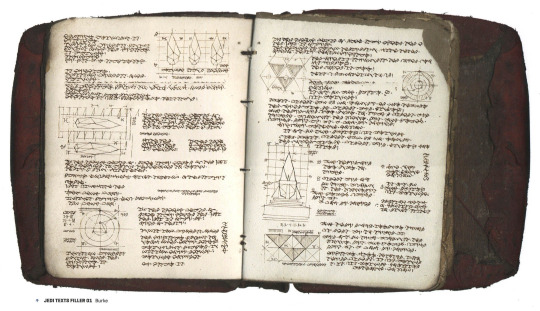
Several unobscured pages of the Sacred Jedi Texts can be seen in The Art of Star Wars: The Rise of Skywalker by Phil Szostak. The pages themselves appear to be assembled from individual blocks of text and illustrations, in order to meet the high demand of pages required for the film.
By cross-referencing these images with the Visual Dictionary, we learn that this language seems to be interchangeably referred to as “Protobesh” and “Coremaic.”
The implied etymology of the name “Coremaic” is that the language comes from the galactic core, the core worlds, or perhaps a specific planet such as Corellia or Coruscant.
“Protobesh“ meanwhile might refer to a precursor/prototypical form of Aurebesh, the most common alphabet in the Old Republic, Imperial, and New Republic eras.
Since many alphabets in Star Wars are simple substitution ciphers for English (equivalent to the in-universe “Basic”), I decided to try an automatic tool to decrypt them. (Boxentriq is my favourite).
After trying various blocks of text, and adjusting the decryption parameters, I was nearly ready to concede that it was untranslatable gibberish, until a single passage caught my attention, from the left-hand page of Jedi Texts Filler 01 by Dan Burke:

I noticed a couple of repeated words, one with 3 letters, and another with 4. After some trial and error, I began to see words resolve throughout the passage:

It reads [sic]:
IN THE SECOND PHASE OF
EACH STAR CYCLE THE JEDI
THE JEDI IS OFFER ED.
ORCE OF THEIR.
While some of the sentences are incomplete, the pendulum had swung entirely the other way, and I was certain it could be translated!
So I turned to the right-hand page to see how accurately I could decipher it.
Translating a Lengthy Passage

There are definitely some new letters mixed in there, but because I had already accounted for over half of the alphabet in the first passage, it was possible to work out the missing letters using context:
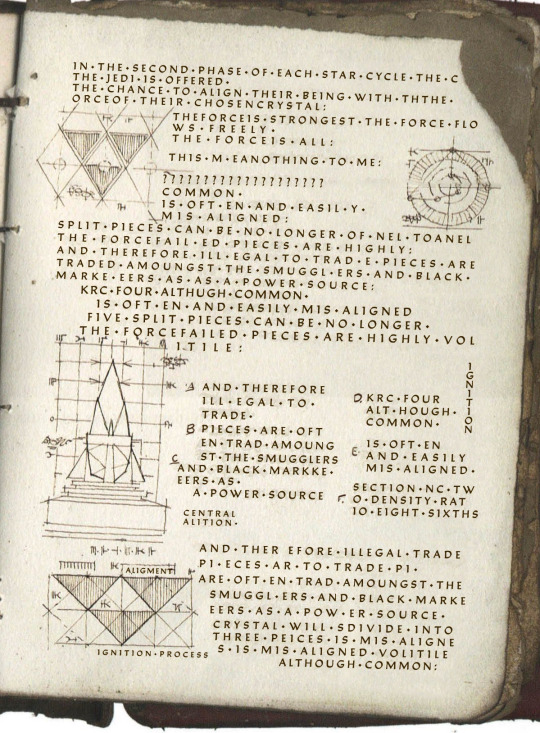
It reads in its entirety [sic]:
IN THE SECOND PHASE OF EACH STAR CYCLE THE C
THE JEDI IS OFFERED
THE CHANCE TO ALIGN THEIR BEING WITH THTHE
ORCEOF THEIR CHOSENCRYSTAL.
THE FORCEIS STRONGEST THE FORCE FLO
WS FREELY
THE FORCE IS ALL.
THIS M EANOTHING TO ME.
[this line is not readable, due to corruption in my source image]
COMMON.
IS OFT EN AND EASIL Y
MIS ALIGNED.
SPLIT PIECES CAN BE NO LONGER OF NEL TOANEL
THE FORCEFAIL ED PIECES ARE HIGHLY.
AND THEREFORE ILL EGAL TO TRAD E PIECES ARE
TRADED AMOUNGST THE SMUGGL ERS AND BLACK
MARKE EERS AS AS A POWER SOURCE.
KRC FOUR ALTHUGH COMMON
IS OFT EN AND EASILY MIS ALIGNED
FIVE SPLIT PIECES CAN BE NO LONGER
THE FORCEFAILED PIECES ARE HIGHLY VOL
ITILE.
A) AND THEREFORE
ILL EGAL TO
TRADE
B) PIECES ARE OFT
EN TRAD AMOUNG
ST THE SMUGGLERS
C) AND BLACK MARKE
EERS AS
A POWER SOURCE
D) KCR FOUR
ALT HOUGH
COMMON
E) IS OFT EN
AND EASILY
MISALIGNED
F) SECTION NC TW
O DENSITY RAT
IO EIGHT SIXTHS
CENTRAL
ALITION
AND THER EFORE ILLEGAL TRADE
PI ECES AR TO TRADE PI
ARE OFT EN TRAD AMOUNGST THE
SMUGGL ERS AND BLACK MARKE
EERS AS A POW ER SOURCE
ALIGNMENT
IGNITION PROCESS
CRYSTAL WILL SDIVIDE INTO
THREE PIECES IS MIS ALIGNE
S IS MIS ALIGNED VOLITILE
ALTHOUGH COMMON.
Making Sense of it All
As you may be able to tell, there are several statements mixed together on this page with varying degrees of coherence.
I have attempted to reconstruct each source-statement as follows:
Regarding a ritual for the spiritual alignment of the crystal with the Jedi’s being:
In the second star cycle, the Jedi is offered the chance to align their being with the Force of their chosen crystal.
The Force is strongest when the Force flows freely. The Force is all.
Regarding the physical alignment of the crystal in the lightsaber:
Central alignment [with an accompanying illustration]
Ignition process [with an accompanying graph]
Section NC-2: Density ratio 8:6
Regarding flawed and damaged crystals:
[Crystals with some particular defect] are often and easily misaligned.
Split pieces can be no longer [functional? useable?].
The Force-failed pieces are highly volatile and therefore illegal to trade.
Pieces are therefore traded amongst the smugglers and black-marketeers as a power source.
Regarding the author’s personal feelings at time of writing:
This means nothing to me.
In Conclusion: Was Yoda Right?
If we take the literal text on the page as canonical, as existing exactly like this in the diegesis of the films, this particular Sacred Text seem to exhibit circular, stream-of-consciousness meditations upon complex scientific, religious, and economic systems. If so, I think we would be justified in agreeing with Yoda that “Page turners they were not.”
As for Phil Szostak’s statement from before, that “designers don’t have time to add Easter eggs, lore hints or layers of symbolism (outside of the obvious). If you’re searching for hidden meaning in #StarWars art, it’s simply not there,” I think it is important that we take it in context.
The concept artists behind Star Wars often do not spend more than a couple of hours on an individual painting. The pressures of the production schedule require artists to work quickly and iteratively. Ideas are thrown out and scrapped at a rapid pace as the story, design, and construction is undertaken.
While these pages are filled with references to kyber crystals and Jedi rituals, there is nothing too profound or complicated discussed. The repetition is the result of quickly copied phrases that are there to fill space and to visually tell a story of the volumes of Jedi texts and the writings they contain. That they contain any lore at all is remarkable, but we must not take that to mean that anything they say is immutable canon.
In other words, take the artist’s words at face-value here: “The Force flows freely. The Force is all. This means nothing to me.”
Resources & Acknowledgements
Here is my Protobesh alphabet chart based on my translations:
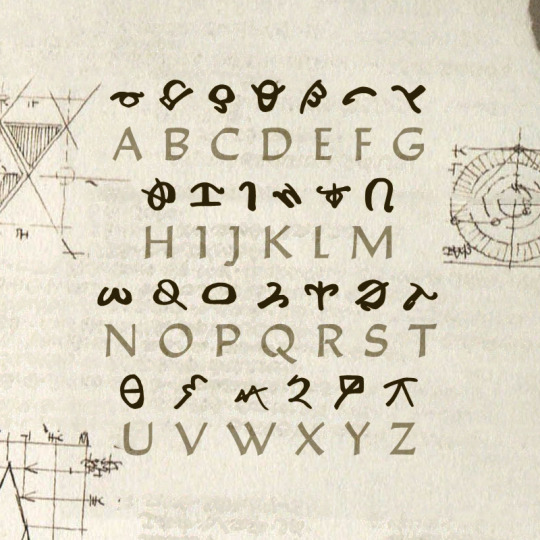
Ender Smith is the editor-in-chief of AurekFonts: the unofficial archive of in-universe Star Wars fonts.
Support future translations and typographic design at ko-fi.com/aurekfonts.
All photos used are the property of Lucasfilm Ltd. They have been used altered and unaltered for educational and critical purposes in accordance with Fair Use law.
#star wars#the last jedi#sacred jedi texts#aurebesh#rise of skywalker#translation#sw-translation#protobesh#coremaic#sjt-translation
45 notes
·
View notes
Text
As some of you may already know, I’ve been a fan of Bakugan for a long time now. It was the very first anime series that I ever watched and is easily among the top 3 shows I enjoyed watching as a kid. As such, while I will admit that the show had some obvious flaws and one or two flimsy plot devices, it can be difficult for me to find anything to actively criticize about it.
One thing I have heard a few people mention in relation to the flimsy plot devices is the sheer number of times Drago evolved over the course of the series which is something I wanted to talk about, not necessarily just about Drago, but the evolution mechanic as a whole.
I don’t really have a structure for this so sorry if it’s a bit of a mess, but anyway...
Before I get into the in-universe mechanics of the whole evolution thing I wanted to start with the boring production side of things. Bakugan was (and still is with the release of the reboot, which I won’t be discussing) a merchandise-driven show. Since the show itself is aimed at younger audiences, this is to be expected, kids like toys and the Bakugan in the show were perfect to base toys off (or to advertise them, depending on how you want to view it).
So, what do you do if you want to base most (if not all) of the merchandising on creatures like the Bakugan? You create a load of them, and one good way of doing that is to use an evolution mechanic since it allows for variety without having to design another creature from scratch. And, since Drago is the main non-human character in the series, it makes sense that he would be merchandised (and, by extension, evolved) the most.
Right, with that out of the way, I can focus on the fun part. How does the evolution mechanic in the series actually work?
I have this show all the way through at least 5 times, however it has been a while since I last sat down to watch it so some parts of this might not be entirely accurate. But I’m confident enough with what I remember that most of this should line up.
Now, I should probably mention the Bakugan I will be discussing in this post. I will be talking about the Bakugan that were partnered with the original Battle Brawlers (with a particular focus on Preyas and Drago), the Resistance Bakugan as a collective, Dharak, and Helios. I won’t be discussing the mechanical Bakugan since they had no evolution process to speak of.
The various Bakugan who have served as part of the main cast over the course of the series have evolved in multiple different ways, either through (what I’m assuming to be) a natural process, or through outside interference.
In season 1, only 1 Bakugan evolved via what I assume to be the natural way, that being Drago. I won’t be discussing Drago too much at this stage since I want to talk about his evolutions as part of their own section, but from what I remember, his first evolution was - arguably - the only time Drago actually evolved without outside interference with the intention of triggering one.
Other Bakugan in season 1 evolved only after they had visited the Doom Dimension. Their evolutions were triggered by the six ancient warriors of Vestroia, after the Bakugan (and their brawling partners) had overcome certain trials that had been designed for them. Could it have been possible for them to evolve without the trials? Yes, considering Drago had managed an evolution of his own before then. Could they have evolved more times? Potentially, the evolution process was never really explained in depth so it’s unclear as to whether there actually is a limit to how many times a Bakugan can evolve.
One Bakugan evolution in season 1 that I found particularly interesting was Preyas. From what we’ve seen over the course of the show, when a Bakugan evolves, their appearance changes to match the boost in power. Preyas, however, did not. Instead, when Preyas evolved he retained his original appearance (though I can’t remember whether or not his power level changed) and instead duplicated into Preyas Angelo/Diablo. This raises some questions about his evolution process in particular. Would it be possible for Preyas to evolve a second time? Or would it be Angelo/Diablo that continues the evolution process if that is at all possible for them? And, the question that I find the most interesting, what would a third evolution look like for Preyas?
Preyas is an attribute-changer, while his default attribute is Aquos (this seems to be a common theme with attribute-changing Bakugan, barring Nemus) he can make use of the other attributes when it is deemed necessary. As such, it isn’t surprising that Angelo and Diablo also possess an affinity for a second attribute (Haos for Angelo, and Pyrus for Diablo). Would another evolution have an affinity for even more attributes? Or would it be exactly like Angelo/Diablo, except with a different attribute affinity? Something to think about.
In season 2, the six ancient warrior Bakugan are - once again - involved in the evolution process of the resistance Bakugan. Except, instead of giving the resistance Bakugan a trial to complete, the evolutions were instead triggered by the Bakugan being given the attribute energy that warriors held in an attempt to protect it. This evolution process was not natural and it follows a similar pattern to season 1 so I won’t linger on it.
One Bakugan that I found particularly interesting in season 2 was Helios. Helios is a dragonoid Bakugan just like Drago, however that’s where the similarities end. It’s fairly obvious that despite them being the same type of Bakugan, their evolutionary chains were very different. While Helios’s heavily involved outside interference, I highly doubt it would have been similar to Drago’s regardless since, again, other than both being classed as dragonoids they aren’t the same Bakugan.
Now, Helios’s evolution process in season 2 is difficult to label as an evolution process since it was largely manufactured in a similar fashion to the mechanical Bakugan, rather than an actual evolution triggered by Helios himself or another entity such as the six ancient warriors or Code Eve (which I will discuss more later). However, both of his cyborg forms were treated as such and so they deserved a mention. The part of his evolution that I particularly wanted to talk about was his evolution into Infinity Helios during season 4. His final evolution (as far as we know anyway) is the only instance where an evolution caused a Bakugan to permanently switch attributes. Other than a brief flashback, we don’t really get to see the evolution take place, but it’s interesting that his attribute changed entirely. Attribute-changers such as Preyas only ever changed their attributes temporarily during a brawl, never for very long, and they always return to their base-attribute once the brawl has ended. This makes me wonder whether there were other Bakugan in the series who had similar evolution requirements that we never got the chance to see.
In terms of evolution, the only Bakugan of season 3 (other than Drago) that I can really talk about is Dharak. Initially, Dharak seemed to be a dragonoid Bakugan similar to Drago and Helios (though his initial four-legged stance reminds me more of Hydranoid’s original form). It is later revealed that he is a descendant of the Bakugan Dharaknoid, meaning that he is not technically a dragonoid Bakugan (depending on how you choose to view the link between Dharaknoid and Genesis Dragonoid). However, his power level was supposedly meant to be equal to Drago’s and when it wasn’t, his DNA sequence was purposefully tampered with to trigger his evolution into Phantom Dharak. There isn’t really much to be said about his evolution since he had the same appearance change and power level boost as every evolved Bakugan, but it wasn’t exactly a natural evolution.
Dharak also evolved into Razenoid after a failed attempt to absorb the power of Code Eve.
All of this brings me to the final Bakugan I wanted to discuss, Drago. As I previously mentioned, Drago is the main Bakugan of the series so it’s to be expected that he would undergo a few evolutions over the course of the series. But why exactly did he evolve so many times?
Drago’s first evolution into Delta Dragonoid was arguably the only time Drago evolved naturally. The evolution itself was alluded to a few times before it actually happened, this involved seemingly random power level surges during brawls and he was noted as being hot to the touch when in ball form at least once. Now, Drago didn’t seem aware that he was evolving until it actually happened, but the concept wasn’t one that he seemed confused by. This evolution was not influenced by by external factors which begs the question, how many times would Drago have evolved without outside interference? I don’t think we’ll ever really get an answer.
His evolution into Ultimate Dragonoid followed the same conditions as the other Battle Brawlers’ Bakugan in season 1 so I’m not going to linger on it.
Drago’s third evolution into Infinity Dragonoid was triggered only after he’d absorbed the Infinity Core. This evolution allowed him to access abilities which could typically only be used by other attributes which automatically makes it one of, if not, the strongest of his evolutions in the entire series. This isn’t entirely surprising since he was holding one of the cores that were responsible for all of Vestroia. He maintained this form when he claimed the Silent Core so the power boost he gained from that is unclear.
Neo Dragonoid (while technically being his fourth evolution) was more of a downgrade which is understandable considering it involved him being seperated from the Perfect Core and its power by extension. He was still able to occasionally tap into and use the energy stored in the core, though the true extent of how much he was able to use at any one time is unclear. He was also temporarily turned into Vexos Dragonoid during this stage however that form wasn’t technically an evolution so I’m not going to discuss it.
His fifth evolution, Cross Dragonoid followed the same conditions as the other Resistance Bakugan in season 2 so I’m not going to linger on it.
Drago evolved into Helix Dragonoid after absorbing the attribute energy stored in the Bakugan Termination System. Despite absorbing the energy of all six attributes, he remained a Pyrus Bakugan and wasn’t able to use abilities of the other attributes which seems strange.
His seventh evolution into Lumino Dragonoid was triggered when he was given The Element in an attempt to protect it from the Gundalians.
He was forced to evolve again into Blitz Dragonoid after defeating Dragonoid Colossus.
His ninth evolution into Titanium Dragonoid occured after gaining the powers of Code Eve. It was this evolution that Drago seemed to struggle with the most since Dharak had been absorbed by Code Eve before he’d been granted the power which led to him experiencing multiple issues which were only really fixed when he evolved for the tenth (and final) time. It is also this evolutionary stage where Drago starts being able to call upon a Mechtagon, though that doesn’t seem to be a specific feature of his evolution considering other Bakugan are able to do the same.
Drago evolved into Fusion Dragonoid using the power of the Gate and Key during the final battle against Mag Mel and Razenoid (formerly Barodius and Dharak).
Overall, many of Drago’s evolutions were not caused naturally. How many times would he have evolved if there had been no outside interference? It’s hard to say.
Many shows, games, etc... that use evolution mechanics typically only allow creatures to evolve twice, so I imagine the same could potentially be true here. However, we never really get in-universe confirmation that a Bakugan has reached its final evolution, sure it’s hinted at occasionally, but if there is a specified limit, it’s not one that show ever tells us.
15 notes
·
View notes
Text
Digging into the Teen Wolf credits
So I fell into a bit of a rabbit hole researching the shift in writing and directing credits in Teen Wolf, trying to find some explanations for the lack of continuity, whiplash change of directions on storylines, and the messiness of the later seasons. A lot of people (myself included) tend to focus on casting issues and Jeff Davis as the be-all-end-all of these issues, but here are a few interesting things I’ve put together:
1. Waning involvement from the original producers/directors -
Russell Mulcahy was a producer/exec on all 100 episodes and directed 39 episodes, including every season finale and all but one season premier (5a). He was a big-shot music video director in the ‘80s. According to his Wikipedia, “Mulcahy's work is recognisable by the use of fast cuts, tracking shots and use of glowing lights, neo-noir lighting, windblown drapery, and fans.”
Tim Andrew came on as a supervising producer and progressed to executive producer, holding a producing credit for all 100 episodes. He directed 35 episodes, including some of fan-favorite suspense episodes like Night School, The Girl Who Knew Too Much, and Riddled.
While their producer credits stayed steady, it’s the director credits that interest me. Between the two of them, they directed 75% of S1, 100% of S2, 83% and 75% of 3a and 3b. S4, it drops to 58%. Back up to 70% and 90% for 5a and 5b, then plummeting to 60% for all of S6. It’s worth noting that S4 is the first season where we start to notice that whiplash effect, not really sure what characters’ motivations are. In one episode, the focus seems to be family financial drama, and then we forget about that and focus on Lydia’s powers. Then the focus is assassins, then Kate Argent - and what the hell is up with Peter?
It’s hard to say for sure, but one could draw the conclusion that the decline in director credits from Andrew and Mulcahy also suggest a decline in interest from them in maintaining the show’s storylines.
In fact, in 5b and season 6, you see a third long-time producer, Joseph Genier, step in to direct a few episodes: the rather sloppy Maid of Gevaudan, Blitzkrieg, and Genotype. We can’t give him too hard a time over it, since his only other directing experience ever was a 2016 Netflix horror movie The Secrets of Emily Blair, shitty even by Netflix standards. He also has some late-season writing credits, but we’ll get to that later.
2. The curious case of Angela Harvey -
In order to understand the writing on TW, you need to know Angela Harvey. She climbed the ranks from personal assistant to writers’ assistant, then, starting in 3a, staff writer.
A staff writer is a salaried, stable figure in the writing department, who works with what is often a rotating door of producers and head writers. They’re usually not the “ideas” person and don’t get the final say, but they help the head writer work through the story and stay on track. Most larger shows have a whole team of staff writers. TW never had more than one at a time.
Shortly after her promotion to staff writer, Harvey got her first full writing credit for Frayed, which is a controversial episode! It’s both praised and detested for the non-linear storyline, the sometimes confusing flashbacks, and Allison’s emotional hallucination of her mother.
After that, she went back to staff writer and was a rock for the show for all of S3 and 4. In S4, she got full writing credit for I.E.D. and Time of Death. Both got mixed reviews on-par with the rest of the muddled mess of S4, but I will note one thing: the human factor. I.E.D., for me, was the first episode that really gave a more rounded picture of Liam, who until that time felt very much like a new puppy coming in to replace our favorite old dogs that went to live on the big farm in the sky.
S5, Harvey gets a promotion to ‘story editor,’ which is pretty much just a title and pay promotion. She wrote A Novel Approach and Strange Frequencies, two more mixed-bag sort of episodes with some golden moments and some crippling larger-story issues. Then she writes the slightly stronger The Sword and the Spirit and...
Gone. She vanishes from the credits for the rest of season 5. I haven’t been able to find any specific explanations, but I did find a rather telling quote from her in an article about how black writers get hired but not promoted in TV: “I repeated staff writer four times,” she said.
Harvey then returns for 6x2 with a shiny new title: executive story editor. I can only draw one conclusion from this sequence of events, which is a contract dispute. Harvey demanded a promotion (as she should have, given her longevity on the show!), was denied, and walked off. The show floundered in her absence and begged her back with the new title.
She got full writer credits for two more episodes for S6 but left the show for good after the second, After Images.
To me, it seems clear that they had a strong, stable voice in Angela, but her commitment to the project waned as she realized that the show had no commitment to her. She may not have been the strongest head writer, but she was an essential core, a beating heart of the show. Her contributions were undervalued and, ultimately, the show suffered because of it.
3. The rotating door of writers -
It’s not unusual for head writers to come and go on shows. Then again, most shows have a stable core in the writers’ room to host those head writers. TW had Jeff Davis, who has frequently been acknowledged to be overly hands-on with the writing (even in episodes he did not take writing credit for), and a single staff writer: Angela Harvey and, before her, Andy Cochran (who was staff writer for S2).
S1 did not have a staff writer, but that was because Jeff had a very firm grip on the story and also because there were only four writers other than Jeff Davis (and the original Teen Wolf movie writers). Interestingly, none of those 4 writers ever returned to the show after S1. This would become a theme for TW writers.
Jeff kept even tighter control on S2, writing 8 of 12 episodes with the help of Cochran. Other than them, there were four other writers, two of whom were a writing team.
Jeff wrote 15 of 24 S3 episodes and brought in 6 new writers and one S2 writer, Christian Taylor who also produced and directed. Of the new writers, only Ian Stokes, who wrote The Fox and the Wolf would become a regular writer afterward (though Alyssa Clark did write two more episodes in S4). Stokes wrote three S4 episodes and three for 5a.
Jeff wrote 6 of 12 episodes in S4, 5 of 10 in 5a, 4 of 10 in 5b, and then did not write again until the series finale.
Starting in Season 4, the writing credits are all over the place. Most writers come in for a single episode and never again. The few notable exceptions are:
Eric Wallace, a later seasons producer
Will Wallace (not sure if related) who was a writers’ assistant that seems to have been randomly granted writing credit for 5a’s Ouroboros, despite having no other writing credits to his name previously. He got writing credit for 4 other episodes in S5 and S6, plus a random staff writer credit for 6a’s Ghosted.
Lindsay Sturman, a lalter seasons producer who now writes and produces for Supergirl.
And producer Joseph Genier who, as he had been allowed to direct later seasons with no previous directing credits, was also allowed head writer credit with no previous writing credits.
What can we divine from this? Chaos, honestly. An inability to resist the uninformed and careless whims of the producers. The lack of lower-level writing staff, who are usually the ones there to give stability and cohesion to the story, meant that every new writer brought in new and contradictory ideas of what the story was about and where it should go. Looking at these credits, I can’t tell if the problem was that everyone wanted to write and writing spots were being given as thank-yous in exchange for producers laying down money or if they had such a difficult time finding quality writers willing to work in that environment that producers had no choice but to step in and write as well as they could given a lack of resources.
4. The vanishing first assistant director -
Compared to the other issues, this one seems minor. However, it seems like TW gave up on the position of ‘first assistant director’ at some point. This position is essentially the right hand of the director, making sure that set runs smoothly and the director has everything they need.
James J.D. Taylor held the position for 50 episodes, including all but 4 episodes in S1-3a. In the first 3, Jeffrey January filled in. For the fourth, Eric Sherman, who would come to be Taylor’s backup, it seems. For 3b and the first half of S4, Sherman and Taylor traded off every other episode. Taylor tried his hand at directing for S4′s Monstrous, at which point Sherman started trading off episodes with Matt Rawls.
Taylor went back to first assistant director for S5, but intermittently and with no backup for his position. 8 of 20 episodes in 5a had no first assistant director. Taylor directed 6x2 and was first assistant for 6x4 and 6x5, but 17 of 20 episodes of S6 had no first assistant.
Sure, there were second assistant and second second assistants, but it seems very odd to neglect such a pivotal position. What is especially baffling is that 6b had first-time directors Tyler Posey, Linden Ashby, and Joseph Genier all working without a first assistant director. To me, this speaks to staffing issues and difficulty organizing a show that was clearly on its last legs.
In summary -
Where the early seasons had focused attention and investment from the original core producers, directors, and the show runner, clearly their attention and care for the project waned over time. They failed to promote the show’s most valuable workers and failed to bring in lower-level staff to do the grunt work in the writers’ room. Instead, they pulled in more and more higher level executives, who tend to have lofty ideas about where a show goes but no willingness to dig into the nitty gritty details. Film schools could make a study of Teen Wolf: “How to run a show into the ground.”
125 notes
·
View notes
Text
Legend of Korra books 3 & 4
Finished rewatching books 3 and 4 of Korra. Here on my thoughts on them and the series as a whole after seeing it again after so many years.
I think books 3 and 4 are pretty solid. Aside from a few flaws, I think 3 is the overall best with the best pacing. I think a big issue with book 2 was that it was trying and failing to juggle a very big cast and multiple subplots that made it feel like a mess. That’s not an issue with 3 or 4, where every character has a relevant purpose and plot threads come together more naturally.
4 does this a little bit worse as I think the plot kind of starts and stops a couple of times, but it’s not terrible. Kuvira’s build up as a villain is very shaky when compared to Amon and Zaheer, but still better than Unalaq’s arc going down the drain. It really does seem like the worst parts of her villainy are told and not shown (those being the reeducation camps and slave labor). I think they could have shown at least one of these camps instead of just seeing the escapees that Varrick and Bolin meet.
I still think the Red Lotus are the best antagonists in LoK just for having the best arc overall. They had Amon’s intrigue, stayed consistent in their motivations like Kuvira, and they have the most dimensions overall just from the little bits of interaction we see of them. What’s more, they didn’t disappoint me in the end.
The Colossus I didn’t mind or find out of place. It just doesn’t bother me when the show has had Koizilla and giant drills in AtLA. I can understand how the mechanics of it work as well. I didn’t feel like my suspension of disbelief was broken considering everything else. I think fans who dislike it are more bothered by it breaking the setting further away from fantasy and into sci-fi.One question though, why does a spirit energy canon need a rifled barrel?
Mako is a much better character in 3 and 4 because he’s finally allowed to be someone other than a love interest. His interactions with Bolin can be really fun and it’s kind of a shame how often they’re separated. I also noticed on a rewatch that he does make a good detective, having good perception and coming up with ideas. It’s better than the pro-bender he started out as and probably his best strength.
I think I actually like Mako now whereas before he was the most forgettable, and I think he deserves some looking into. A lot of the hate comes from him being put into really tough spots where he just can’t win. Mako goes from being extremely aloof to being a loyal but beleaguered straight man to the group.
Raiko I feel similarly to Mako. I think he’s another guy who keeps getting put into tough spots with no easy solution. He doesn’t really deserve hate either, and honestly probably made the best decisions he could as a president (I know from experience how bad they can be...) Him being hated and voted out in the comics seem like Bryke was over correcting, something they seem to do a lot.
Suyin I have mixed feelings on. She really does seem like someone Bryke really wanted fans to like and agree with, but they shilled her a bit too much and at the expense of Lin. Su’s apology to Lin at the end of their dispute felt kind of half-hearted, and despite being justified, the whole thing is framed as Lin being the one in the wrong, stuck in the past, unable to move on after Su had changed. We don’t see Su change though, and Su keeps acting like what she did wasn’t that big a deal, so it falls flat.
What’s more, Su continues being a big presence into book 4, and I think I have to agree with Kuvira that Su should have at least done something to help the EK out. It really does make Su come off as kind of a cowardly hypocrite who’s so afraid of looking like a dictator that she doesn’t even try to help. She doesn’t want to be treated like royalty or an authoritarian, but if you look at Zaofu the place is already set up like a small kingdom, with the Beifongs being the divine bloodline descended from Toph, the strongest bender to ever live. Su is a queen in all but name, and if she was so afraid of looking like a dictator she could have just given up the power like Kuvira was supposed to have done. Su just rubs me the wrong way from start to finish, and it’s partly because the show doesn’t challenge her or make her change. It just expects us to see her as being right, and she just isn’t.
Bolin being a lava bender I remember being really excited for, because it was something I predicted when I first saw it years ago. I don’t have a problem with how he discovered it. It’s not the best way I’d like see someone discover a new power, but I think it’s better than when Korra finally got airbending (though that didn’t bother me too much either). It just kind of made sense to me and finally gave something else to stand out besides comic relief.
The air kids got better in 3 and 4 too. Meelo got less annoying, Jinora was more fleshed out, and I actually really like Ikki in book 4.
Now Korra and Asami. I think Korra is maybe at her most static in book 3, but her arc in book 4 is the most interesting as she had to build herself back up. I don’t agree with some of the things that are just told to the viewer, like how she needed to learn from her enemies. At the finale Korra says she had to suffer to learn compassion, but it’s not like Korra wasn’t a compassionate person already. Korra’s arc seemed more centered on dealing with trauma and finding her purpose in a world that seemed hellbent on telling her she wasn’t needed. I don’t know if that was some kind of meta commentary, but it does work.
I do like Korra’s overall development from where she was in book 1. If I had to put it into words, I think her story is about trying to fulfill a role that she’s been groomed for her whole life, trying to live up to expectations, pushed into doing what others want her to do, failing those things, then finding the strength and resolve to achieve success on her own terms, even if it’s not what everyone wants. Korra gradually learns to stop being a tool for world leaders to use to keep order or power. It’s not always done well, but it’s there.
It’s nice to see her and Asami be friends after the love triangle stuff. It’s kind of surprising, but they didn’t really interact all that much in the first two books all things considered. Asami doesn’t change a whole lot throughout the series, but her reconnecting with her dad at the end felt satisfying.
I’ll be honest, I never really saw Korrasami happening and didn’t view much of their interactions as being romantic in nature. I think only the letter writing and their reunion seems a little shippy, but not very obvious. That said, I can buy the two of them finally realizing they might be attracted to each other at the finale, as a beginning to their relationship. The real problem is that shippers and even Bryke overhyped this moment up as it being ENDGAME rather than treating it as what is was, a spark of attraction. Korra and Asami aren’t in love yet, they’re just going on their first official date.
I do like them being together though. It seems a lot healthier than other potential relationships, and let’s be real here; Asami NEEDED something to make her happy because holy shit has she be through a lot by the end of the series. Dumped by Mako twice, almost lost her company and lost her dad after she forgave him. Give the poor rich girl a break.
So, final thoughts on the series as a whole; it’s not as good as AtLA, but that’s mostly on the execution. LoK was messy and had issues, but it did eventually smooth things out after a lot of course correcting. There are things I don’t like, but not enough for me to write it off, and it has plenty of strengths that make it deserving of a watch if you keep an open mind.
I remember ThunderCats 2011 getting a lot of flak too, and that’s one of my favorite shows ever despite its glaring flaws, so I really can’t work up the energy to trash LoK. I know plenty of people can connect to it even if I don’t, at least not fully, and I honestly do believe that overall LoK’s strengths outweigh its flaws, even if it can be inconsistent and unpolished.
LoK may take place in the same world as AtLA, but it is a very fundamentally different series, and beyond a few very core basics of storytelling I think it’s a little unfair to compare the two. It’s not the masterpiece it could have been, but at the end I still enjoyed it. I might have more thoughts later, but these are what I have for now.
15 notes
·
View notes
Text
Gender and Race in Zelda Games - Pt 1
Hey, can we talk about how the Gerudo’s defining trait is their gender? It’s very explicitly marketed to the player that they are an all female race and that has a lasting impact on their culture and how they interact with other races, considering they are reproductively compatible with hylians (and is the only way to ensure their survival as a race).
Although Nintendo likes to distance themselves from any political statements, the Zelda franchise does give an insight into their views on gender identity and racial representation. I’m going to be mostly going off of Breath of the Wild (and a bit of OoT) for this.
There are 7 major civilised races in BOTW’s Hyrule, and they’re mainly based on standard tropes of the high fantasy genre, which has most of its roots in the works of J.R.R. Tolkien. Things like the Elder Scrolls and DnD follow a similar set of race tropes. Basically in a nutshell:
Hylians = Humans (protagonist material, has a far reaching empire, medieval aesthetic, predominantly white because yay colonialism amirite)
Zora = Elves (attuned with nature, long life/immortality, thinks they’re better than you, thin/sexy/youthful appearance, feminine)
Gorons = Dwarves (associated with earth, overtly masculine, stocky/stout appearance, b e a r d s)
Koroks = Halflings/Hobbits (smol, associated with plants and greenery, often the starting point in a story, disconnected from the world, humble people, old english farmer aesthetic)
Gerudo = Orc/Haradrim/Khajiit (the Oppressed Minority, often desert people, has an ”Exotic” accent/language, vague mix of middle-eastern, african and/or south american aesthetics)
Rito = Bird People (free spirits, archery for days, native american/canadian aesthetic)
Sheikah = The Asians (tm) (the wise philosophical ones, always has a shrivelled up old Confucian-inspired leader, are probs ninjas)
First of all, no, Hylians are not elven-coded; just because they have pointed ears does not equal elf. The way they are coded in the text is very much human.
So I’m going to elaborate a bit more on the Gerudo here for this post, since they are the strongest example of what my whole point of this is. I’ll be talking about the Gorons in another post later down the track (that’s a whole other can o beans).
Ocarina of Time is where we are first introduced to the Gerudo as a race, and red flag number one comes up: the main villain is Gerudo. The only man in an entire race of women, who has automatically assumed de-facto leadership because of his gender. Hmm. Okay then, game.
Because of Ganondorf’s actions throughout OoT, the Gerudo garner a sour reputation amongst the other races, and a lot of this context comes from reactions to Link wearing the Gerudo Mask. Many are terrified or unsettled by the mask, such as King Zora, some will comment on how it reminds them of a woman in their life, and Darunia very gruffly states how much he hates the Gerudo (wow dude, not cool). There is an everpresent stigma against them as a people, one that only compounds in the Adult time after Ganondorf takes over. In Windwaker, Ganondorf talks about how his original motivation was to take Hyrule for its resources, as his people were suffering in the desert whilst Hyrule florished. But his actions only caused them more suffering, as he seemed not to care for his people once he took Hyrule Castle, and the Gerudo could no longer mingle with Hylians, because this takeover increased the stigma against the Gerudo tenfold.
This stigma was so great that even in Breath of the Wild, thousands of years later, their people are still recovering from their collective shame (eg. Urbosa). Look how long its taken Germany to recover post WWII, and some still hold grudges against them, even though they’re now practically one of the most anti-Nazi nations ever. But clear strides have been made in Gerudo culture - they now seem to be a proud people, embracing both their strength and their femininity. But a new interesting issue arises.
It’s alarming how much suggestion there is in BotW that the Gerudo are being taken advantage of. Men are barred from city walls, and for good reason. All of the men outside of the walls are there for the sole purpose of entering the Forbidden Garden, as it were. Like the men at the bazaar who freeze up when they see lady Link. Or the creepy guy with the sand boots circling the town like a hawk in the hopes of catching a lady’s eye. There are a couple of guys in trouble on the other side of the desert you can save (from a lizalfos I think? If memory serves), and all they will talk about is how Gerudo Town is some kind of paradise of hot women, like they’re using their dicks as a compass. I hope they never get there. And to top it all off, there’s Voe and You, an entire dating class teaching women on how to interact with men, and how to walk the line between being cautious of predators, and not being Risa.
I don’t know how to articulate how this messes with my brain, and I’m very bad at conclusions. Nonetheless, what I am trying to say is this. What does this all tell us about how Nintendo writes women, and how the changing times have affected the representation of women in Zelda? Why are there entire races who are tied to their gender? This trend of coding races to a gender in video games isn’t confined to the Zelda series either, its present in a lot of Nintendo games (if I may gesture to the Lochladies from Mario Odyssey), and media as a whole. Is this a good thing? What is the purpose? I don’t know how to answer those questions. There is always a form of subconscious meaning ascribed to the stories we tell, whether we intend to or not. I don’t know what to do with this information really, its just something to think about. And this is a starting point too, there’s a lot more to be said if you start training your eye to look for these things in the games you’re playing, especially Nintendo games, since they seem to have been free from The Discourse because of how they market their company to be so Opinionless and therefore accomodating to people from all backgrounds. But they most certainly aren’t opinionless.
Disclaimer: I do not believe that Nintendo are trying to push some Political Agenda (the opposite, actually), it’s mostly subconscious coding and association due to, as I mentioned, for us as people to express our own views through story.
Segway to part 2: I said at the start that it’s strange how the femininity of the Gerudo is so heavily highlighted, and its a core part of their identity as a race. So why the hell does this not apply to the freaking GORONS?
Have a nice day, and thanks for reading my rambles :D
8 notes
·
View notes